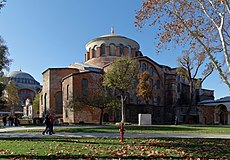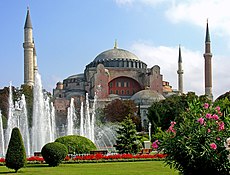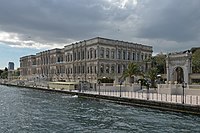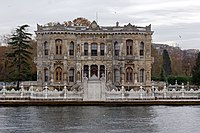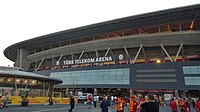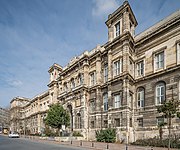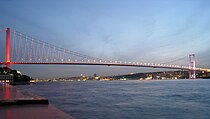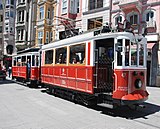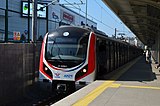Стамбул
Стамбул Стамбул | |
|---|---|
 | |
OpenStreetMap | |
| Координаты: 41 ° 00'49 "с.ш. 28 ° 57'18" в.д. / 41,01361 ° с.ш. 28,95500 ° в.д. | |
| Страна | |
| Область | Мраморное море |
| Провинция | Стамбул |
| Провинциальный центр | Чагалоглу , Фатих |
| Районы | 39 |
| Правительство | |
| • Тип | Мэр – правительство совета |
| • Тело | Муниципальный совет Стамбула |
| • Мэр | Экрем Имамоглу ( ТЭЦ ) |
| Область | |
| • Городской | 2576,85 км 2 (994,93 квадратных миль) |
| • Метро | 5343,22 км 2 (2063,03 квадратных миль) |
| Самая высокая точка | 537 м (1762 фута) |
| Население (31 декабря 2023 г.) [3] | |
| • Столичный муниципалитет и провинция | 15,655,924 |
| • Классифицировать | 1 место в Европе 1 место в Турции |
| • Городской | 15,305,657 |
| • Плотность города | 5939/км 2 (15 380/кв. миль) |
| • Плотность метро | 2930/км 2 (7600/кв. миль) |
| Demonym | Стамбульец ( турецкий : Стамбульец ) |
| ВВП (номинальный) (2022) | |
| • Столичный муниципалитет и провинция | ₺ 4,564 миллиарда долларов США 276 миллиардов |
| • На душу населения | ₺ 287,524 17 349 долларов США |
| Часовой пояс | UTC+3 ( ТРТ ) |
| Почтовый индекс | от 34000 до 34990 |
| Коды городов |
|
| Регистрация автомобиля | 34 |
| ИЧР (2021 г.) | 0.867 [6] ( очень высокий ) · 1 место |
| ГеоДВУ | .ist , .Стамбул |
| Веб-сайт | |
| Официальное название | Исторические районы Стамбула |
| Критерии | Культурные: (i)(ii)(iii)(iv) |
| Ссылка | 356бис |
| Надпись | 1985 г. (9-я сессия ) |
| Расширения | 2017 |
| Область | 765,5 га (1892 акра) |
Стамбул [б] Это крупнейший город Турции . , расположенный на проливе Босфор , границе между Европой и Азией Он считается экономической, культурной и исторической столицей страны. В городе проживает более 15 миллионов жителей, что составляет 19% населения Турции. [3] и является самым густонаселенным городом Европы [с] в мире и пятнадцатый по величине город .
Город был основан в Византии в VII веке до нашей эры греческими поселенцами из Мегары . [9] В 330 году нашей эры римский император Константин Великий сделал его своей имперской столицей, сначала переименовав его в Новый Рим ( древнегреческий : Νέα Ῥώμη Nea Rhomē ; латынь : Nova Roma ). [10] а затем, наконец, как Константинополь ( Константинополис ) после себя. [10] [11] В 1930 году название города было официально изменено на «Стамбул» - турецкий перевод εἰς τὴν Πόλιν eis tḕn Pólin «город», названия, которое носители греческого языка использовали с 11 века для разговорного обозначения города. [10]
Город служил имперской столицей почти 1600 лет: во времена Византийской (330–1204), Латинской (1204–1261), поздневизантийской (1261–1453) и Османской (1453–1922) империй. [12] Город рос в размерах и влиянии, в конечном итоге став маяком Шелкового пути и одним из самых важных городов в истории. Город сыграл ключевую роль в развитии христианства в римские и византийские времена, приняв четыре из первых семи вселенских соборов, прежде чем он превратился в исламский оплот после падения Константинополя в 1453 году нашей эры, особенно после того, как он стал резиденцией Османского халифата. в 1517 году. [13] В 1923 году, после турецкой войны за независимость , Анкара заменила город столицей вновь образованной Турецкой Республики.
Стамбул был культурной столицей Европы 2010 года . Город обогнал Лондон и Дубай и стал самым посещаемым городом в мире: в 2023 году его посетили более 20 миллионов иностранных туристов. [14] Исторический центр Стамбула является объектом Всемирного наследия ЮНЕСКО , а в городе расположены штаб-квартиры многочисленных турецких компаний, на долю которых приходится более тридцати процентов экономики страны . [15] [16]
Имена
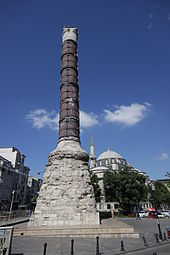
Первое известное название города — Византия ( греч . Βυζάντιον Byzántion ), имя, данное ему при его основании мегарскими колонистами около 657 г. до н.э. [10] [18] Мегарские колонисты утверждали, что они напрямую связаны с основателем города Визой, сыном бога Посейдона и нимфы Сероэссы. [18] Современные раскопки позволили предположить, что название «Византия» может отражать места коренных фракийских поселений, которые предшествовали созданию полноценного города. [19] Константинополь происходит от латинского имени Константин , в честь Константина Великого , римского императора, заново основавшего город в 324 году нашей эры. [18] Константинополь оставался наиболее распространенным названием города на Западе до 1930-х годов, когда турецкие власти начали настаивать на использовании слова «Стамбул» ( турецкий : İstanbul). [д] ) на иностранных языках. Ḳosṭanṭiniye ( османский турецкий язык : قسطنطينيه ) и Стамбул были названиями, которые попеременно использовались османами во время их правления. [20]
Название Стамбул ( османский турецкий язык : Стамбул ) Турецкое произношение: [isˈtanbuɫ] разговорный Турецкое произношение: [ɯsˈtambuɫ] ), как правило, происходит от средневековой греческой фразы εἰς τὴν Πόλιν ( Греческое произношение: [is tim ˈbolin] ), буквально «в город». [21] и именно так местные греки называли Константинополь. Это отражало его статус единственного крупного города в окрестностях. Важность Константинополя в османском мире также отражалась в его прозвище Дерсаадет ( османский турецкий язык : درساعدت ), что на османском турецком означает «Ворота к процветанию». [22] Альтернативная точка зрения состоит в том, что название произошло непосредственно от «Константинополь» с опущением первого и третьего слогов. [18] Некоторые османские источники 17 века, такие как Эвлия Челеби , описывают его как общее турецкое имя того времени; между концом 17 и концом 18 веков он также использовался официально. Первое использование слова «Исламбол» ( османский турецкий язык : اسلامبول ) на монетах произошло в 1730 году во время правления султана Махмуда I. [23] На современном турецком языке название пишется как «Истанбул» с точкой İ, поскольку в турецком алфавите различаются буквы « с точкой и I» без точки . В английском языке ударение падает на первый или последний слог, а в турецком – на второй слог ( -tan- ). [24] Человек из города — Стамбулу (множественное число İstanbullar ); Стамбулит используется в английском языке. [25]
История
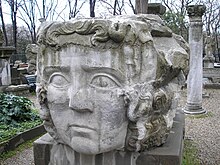
Артефакты неолита , обнаруженные археологами в начале 21 века, указывают на то, что исторический полуостров Стамбул был заселен еще в 6 тысячелетии до нашей эры. [26] Это раннее поселение, сыгравшее важную роль в распространении неолитической революции с Ближнего Востока на Европу, просуществовало почти тысячелетие, прежде чем было затоплено повышением уровня воды. [27] [26] [28] [29] Первое человеческое поселение на азиатской стороне, курган Фикиртепе, относится к периоду медного века , с артефактами, датируемыми 5500–3500 годами до нашей эры. [30] На европейской стороне, недалеко от мыса полуострова ( Сарайбурну ), в начале I тысячелетия до нашей эры находилось фракийское поселение. Современные авторы связывают его с фракийским топонимом Лигос , [31] упоминается Плинием Старшим как более раннее название города Византия. [32]
История самого города начинается около 660 г. до н.э. [10] [33] [и] когда греческие поселенцы из Мегар основали Византию на европейской стороне Боспора. Поселенцы построили акрополь рядом с Золотым Рогом на месте ранних фракийских поселений, что способствовало развитию экономики зарождающегося города. [39] Город пережил короткий период персидского правления на рубеже V века до нашей эры, но греки отбили его во время греко-персидских войн . [40] Затем Византия продолжала оставаться частью Афинской лиги и ее преемницы, Второй Афинской лиги , прежде чем обрела независимость в 355 году до нашей эры. [41] Византия, долгое время находившаяся в союзе с римлянами, официально стала частью Римской империи в 73 году нашей эры. [42] Решение Византии встать на сторону римского узурпатора Песценния Нигера против императора Септимия Севера стоило ей дорого; к тому времени, когда он сдался в конце 195 г. н.э., два года осады оставили город опустошенным. [43] Пять лет спустя Север начал восстанавливать Византию, и город вновь обрел — и, по некоторым сведениям, превзошел — свое прежнее процветание. [44]
Византийская эпоха
Константин Великий фактически стал императором всей Римской империи в сентябре 324 года. [45] Два месяца спустя он изложил планы строительства нового христианского города на месте Византии. Будучи восточной столицей империи, город назывался Нова-Рома ; большинство называли его Константинополем, и это название сохранилось до 20 века. [46] 11 мая 330 г. Константинополь был провозглашен столицей Римской империи, которая позже была навсегда разделена между двумя сыновьями Феодосия I после его смерти 17 января 395 г., когда город стал столицей империи; в течение следующего тысячелетия римской истории государство обычно называли «Византийской империей». [47]
Основание Константинополя было одним из самых значительных достижений Константина, сместившим римскую власть на восток, поскольку город стал центром греческой культуры и христианства. [47] [48] По всему городу были построены многочисленные церкви, в том числе собор Святой Софии , построенный во время правления Юстиниана I и остававшийся крупнейшим собором в мире на протяжении тысячи лет. [49] Константин также предпринял капитальную реконструкцию и расширение Константинопольского ипподрома ; вмещая десятки тысяч зрителей, ипподром стал центром общественной жизни, а в V и VI веках — центром беспорядков, в том числе беспорядков в Нике . [50] [51] Местоположение Константинополя также гарантировало, что его существование выдержит испытание временем; на протяжении многих столетий его стены и набережная защищали Европу от захватчиков с востока и распространения ислама. [48] На протяжении большей части Средневековья , во второй половине византийской эпохи, Константинополь был самым большим и богатым городом на европейском континенте, а иногда и самым большим в мире. [52] [53] Константинополь принято считать центром и «колыбелью православной христианской цивилизации ». [54] [55]
Константинополь начал непрерывно приходить в упадок после окончания правления Василия II в 1025 году. Четвертый крестовый поход был отвлечен от своей цели в 1204 году, и город был разграблен и разграблен крестоносцами. [56] Они основали Латинскую империю на месте православной Византийской империи. [57] Собор Святой Софии был преобразован в католическую церковь в 1204 году. Византийская империя была восстановлена, хотя и ослаблена, в 1261 году. [58] Церкви, оборонительные сооружения и основные службы Константинополя находились в плохом состоянии. [59] и его население сократилось до ста тысяч с полумиллиона в 8 веке. [ф] Однако после завоевания 1261 года некоторые памятники города были восстановлены, а некоторые, например две деисусные мозаики в соборе Святой Софии и Карие, были созданы. [60]
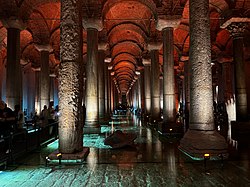
Различные экономические и военные меры, установленные Андроником II Палеологом , такие как сокращение вооруженных сил, ослабили империю и сделали ее уязвимой для атак. [61] В середине 14 века турки-османы начали стратегию постепенного захвата небольших городов и поселков, отрезая пути снабжения Константинополя и медленно его удушая. [62] 29 мая 1453 года, после восьминедельной осады, в ходе которой был убит последний римский император Константин XI , султан Мехмед II «Завоеватель» захватил Константинополь .
Османская империя
Султан Мехмед объявил Константинополь новой столицей Османской империи . Через несколько часов после падения города султан поехал в собор Святой Софии и вызвал имама, чтобы тот провозгласил шахаду , превратив величественный собор в императорскую мечеть из-за отказа города сдаться мирно. [63] Мехмед объявил себя новым Кайзер-и Румом , османско-турецким эквивалентом Римского Цезаря , и Османское государство было реорганизовано в империю. [64] [65]

После захвата Константинополя Мехмед II немедленно приступил к возрождению города. Понимая, что возрождение потерпит неудачу без повторного заселения города, Мехмед II приветствовал всех – иностранцев, преступников и беглецов – демонстрируя чрезвычайную открытость и готовность принять чужаков, которые пришли определять политическую культуру Османской империи. [66] Он также пригласил людей со всей Европы в свою столицу, создав космополитическое общество, которое просуществовало на протяжении большей части периода Османской империи. [67] Оживление Стамбула также потребовало масштабной программы реставрации всего, от дорог до акведуков . [68] Как и многие монархи до и после, Мехмед II преобразил городской ландшафт Стамбула, осуществив масштабную реконструкцию центра города. [69] Появился огромный новый дворец , если не затмевать , который мог конкурировать со старым его , новый крытый рынок (до сих пор называющийся Гранд-базаром ), портики, павильоны, дорожки, а также более дюжины новых мечетей. [68] Мехмед II превратил ветхий старый город в нечто, похожее на имперскую столицу. [69]
Социальная иерархия была проигнорирована безудержной чумой, которая убивала как богатых, так и бедных в 16 веке. [70] Деньги не могли защитить богатых от всех неудобств и суровых сторон Стамбула. [70] Хотя султан жил в безопасном отдалении от масс, а богатые и бедные, как правило, жили бок о бок, по большей части Стамбул не был зонирован, как современные города. [70] Роскошные дома располагались на одних и тех же улицах и в кварталах с крохотными лачугами. [70] У тех, кто был достаточно богат, чтобы иметь уединенную загородную недвижимость, был шанс избежать периодических эпидемий болезней, опустошавших Стамбул. [70]
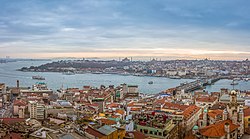
Османская династия заявила о статусе халифата в 1517 году, а Константинополь оставался столицей этого последнего халифата в течение четырех столетий. [13] Правление Сулеймана Великолепного с 1520 по 1566 год было периодом особенно великих художественных и архитектурных достижений; Главный архитектор Мимар Синан спроектировал несколько знаковых зданий в городе, в то время как османское искусство керамики , витражей , каллиграфии и миниатюры процветало. [71] К концу 18 века население Константинополя составляло 570 000 человек. [72]
Период восстания в начале 19 века привел к возвышению прогрессивного султана Махмуда II и, в конечном итоге, к периоду Танзимата , который привел к политическим реформам и позволил внедрить в город новые технологии. [73] В этот период были построены мосты через Золотой Рог. [74] а Константинополь был связан с остальной частью европейской железнодорожной сети в 1880-х годах. [75] Современные объекты, такие как сеть водоснабжения, электричество, телефоны и трамваи, постепенно вводились в Константинополь в течение следующих десятилетий, хотя и позже, чем в других европейских городах. [76] Усилий по модернизации было недостаточно, чтобы предотвратить упадок Османской империи . [77]
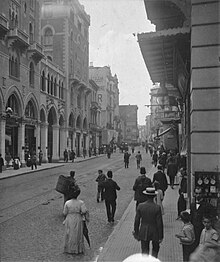
После младотурецкой революции 1908 года Османский парламент , закрытый с 14 февраля 1878 года, был вновь открыт 30 лет спустя, 23 июля 1908 года, что ознаменовало начало Второй конституционной эры . [78] Гражданские беспорядки и политическая нестабильность в Османской империи в течение нескольких месяцев после революции побудили Австро-Венгрию аннексировать Боснию и Болгарию и провозгласить свою независимость совместно скоординированным шагом 5 октября 1908 года. Султан Абдул Хамид II был свергнут в 1909 году после попытка контрреволюции, известная как инцидент 31 марта . Ряд войн начала 20-го века, таких как Итало-турецкая война (1911–1912) и Балканские войны (1912–1913), поразили столицу больной империи и привели к османскому государственному перевороту 1913 года , который принес режим Трех Паш . [79]
Османская империя вступила в Первую мировую войну (1914–1918) на стороне Центральных держав и в конечном итоге потерпела поражение. Депортация армянской интеллигенции 24 апреля 1915 года была одним из главных событий, ознаменовавших начало геноцида армян во время Первой мировой войны. [80] Из-за османской и турецкой политики тюркизации и этнических чисток население города христианское сократилось с 450 000 до 240 000 в период с 1914 по 1927 год. [81] было Мудросское перемирие подписано 30 октября 1918 года, а союзники оккупировали Константинополь 13 ноября 1918 года. Османский парламент был распущен союзниками 11 апреля 1920 года, а османская делегация во главе с Даматом Ферид-пашой была вынуждена подписать Севрский мирный договор . 10 августа 1920 г. [ нужна ссылка ]
После турецкой войны за независимость (1919–1922) Великое национальное собрание Турции в Анкаре 1 ноября 1922 года упразднило султанат, а последний османский султан Мехмед VI был объявлен персоной нон грата . Покинув борт британского военного корабля HMS Malaya 17 ноября 1922 года, он отправился в изгнание и умер в Сан-Ремо , Италия, 16 мая 1926 года.
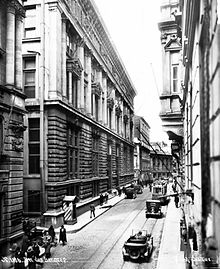
был Лозаннский мирный договор подписан 24 июля 1923 года, а оккупация Константинополя завершилась с уходом последних сил союзников из города 4 октября 1923 года. [83] Турецкие войска правительства Анкары под командованием Шюкрю Наили-паши (3-й корпус) вошли в город с церемонией 6 октября 1923 года, которая была отмечена как «День освобождения Стамбула» ( İstanbul'un Kurtuluşu ), и была С тех пор его отмечают ежегодно. [83]
Турецкая Республика
29 октября 1923 года Великое Национальное Собрание Турции провозгласило создание Турецкой Республики со столицей в Анкаре. Мустафа Кемаль Ататюрк республики стал первым президентом . [84] [85]
Налог на богатство 1942 года, взимаемый в основном с немусульман, привел к передаче или ликвидации многих предприятий, принадлежавших религиозным меньшинствам. [86] С конца 1940-х и начала 1950-х годов Стамбул претерпел большие структурные изменения: по всему городу были построены новые общественные площади, бульвары и проспекты, иногда за счет исторических зданий. [87] Население Стамбула начало быстро увеличиваться в 1970-х годах, когда люди из Анатолии мигрировали в город в поисках работы на многочисленных новых заводах, построенных на окраинах обширного мегаполиса. Этот внезапный резкий рост населения города вызвал большой спрос на жилье, и многие ранее отдаленные деревни и леса оказались поглощены столичным районом Стамбула. [88]
География и окружающая среда
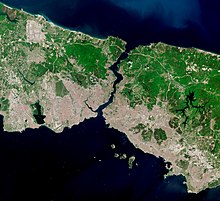
Стамбул находится на северо-западе Турции и расположен на проливе Босфор , который обеспечивает единственный проход из Черного моря в Средиземное через Мраморное море . [15] Исторически город был идеально расположен для торговли и обороны: место слияния Мраморного моря, Босфора и Золотого Рога обеспечивает как идеальную защиту от нападения противника, так и естественные ворота для взимания платы за проезд. [15] несколько живописных островов — Бююкада , Хейбелиада , Бургазада , Кыналыада и пять островов поменьше. В состав города входят [15] Береговая линия Стамбула вышла за пределы своих естественных пределов. Большие участки Каддебостана расположены на свалках, в результате чего общая площадь города увеличивается до 5343 квадратных километров (2063 квадратных миль). [15]
Несмотря на миф о том, что город составляют семь холмов , на самом деле в черте города находится более 50 холмов. Самый высокий холм Стамбула, Айдос, имеет высоту 537 метров (1762 фута). [15]
Землетрясения
Северо -Анатолийский разлом под Мраморным морем замыкается к югу от города. [89] Этот разлом стал причиной землетрясений 1766 и 1894 годов . [90] и землетрясение магнитудой не менее 7,0 весьма вероятно в 21 веке, [91] хотя землетрясение магнитудой выше 7,5 считается невозможным. [92] Управление сейсмических и наземных исследований муниципалитета Стамбула отвечает за анализ методов снижения городского сейсмического риска . [93] национальное правительство, контролируемое правительством, Президентство по управлению стихийными бедствиями и чрезвычайными ситуациями отвечает тогда как за реагирование на чрезвычайные ситуации при землетрясении , и ему будут помогать такие неправительственные организации, как İHH . [94]
Угроза сильных землетрясений играет большую роль в развитии инфраструктуры города: с 2012 года было снесено и заменено более 500 000 уязвимых зданий. [90] Согласно заявлениям министерства и комментариям геологов, сделанным в 2023 году, инфраструктура города находилась в достаточно хорошем состоянии, однако из-за очень высоких затрат здания не были в этом состоянии: более полумиллиона квартир по-прежнему были уязвимы для обрушения, а количество жертв во многом зависит от того, сколько крах. [95] [96] [97] По состоянию на 2024 год [update]Большинство зданий в Стамбуле были построены с учетом низких сейсмических стандартов в 20 веке, [98] Жители считают, что город недостаточно подготовлен к землетрясению . [99]
Климат
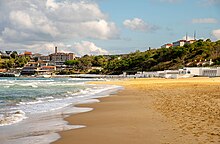
Климат Стамбула умеренный и часто описывается как переходный между средиземноморским климатом, типичным для западного и южного побережий Турции, и океаническим климатом северо-западного побережья страны. [100] Однако существуют большие расхождения в терминологии, используемой для классификации климата города .
Лето в городе от теплого до жаркого и умеренно сухое, со средней дневной температурой около 28 ° C (82 ° F) и менее 7 дней с осадками в месяц. Несмотря на общепринятый температурный диапазон, середина лета в Стамбуле считается умеренно некомфортной из-за высоких точек росы и относительной влажности. [101] Зимы, тем временем, прохладные, довольно дождливые и относительно многоснежные для города со средней температурой выше нуля.
Осадки в Стамбуле распределяются неравномерно: в зимние месяцы выпадает как минимум вдвое больше осадков, чем в летние. Режим осадков также варьируется в зависимости от сезона. Зимние осадки обычно легкие, постоянные и часто представляют собой смешанные осадки, такие как дождевые и снежные смеси и крупа ; тогда как летние осадки обычно резкие и спорадические. Облачность, как и осадки, сильно варьируется в зависимости от сезона. Зимы довольно облачные: около 20 процентов дней солнечные или переменная облачность. Между тем летом здесь бывает 60-70 процентов возможного солнечного света.
Snowfall is sporadic, but accumulates virtually every winter; and when it does, it is highly disruptive to city infrastructure. Sea-effect snowstorms with more than 30 centimetres (1 ft) of snowfall happen almost annually, most recently in 2022.[102][103]
| Climate data for Kireçburnu (normals 1991–2020, precipitation days and sunshine 1981-2010; see the main article for more information) | |||||||||||||
|---|---|---|---|---|---|---|---|---|---|---|---|---|---|
| Month | Jan | Feb | Mar | Apr | May | Jun | Jul | Aug | Sep | Oct | Nov | Dec | Year |
| Mean daily maximum °C (°F) | 8.8 (47.8) | 9.4 (48.9) | 12.0 (53.6) | 16.1 (61.0) | 21.0 (69.8) | 25.7 (78.3) | 28.0 (82.4) | 28.2 (82.8) | 24.6 (76.3) | 19.9 (67.8) | 15.0 (59.0) | 10.7 (51.3) | 18.3 (64.9) |
| Daily mean °C (°F) | 5.9 (42.6) | 6.1 (43.0) | 8.0 (46.4) | 11.5 (52.7) | 16.3 (61.3) | 21.1 (70.0) | 23.7 (74.7) | 24.2 (75.6) | 20.5 (68.9) | 16.2 (61.2) | 11.7 (53.1) | 7.9 (46.2) | 14.4 (58.0) |
| Mean daily minimum °C (°F) | 3.6 (38.5) | 3.5 (38.3) | 4.9 (40.8) | 8.1 (46.6) | 12.8 (55.0) | 17.4 (63.3) | 20.3 (68.5) | 21.2 (70.2) | 17.4 (63.3) | 13.6 (56.5) | 9.2 (48.6) | 5.5 (41.9) | 11.5 (52.6) |
| Average precipitation mm (inches) | 96.1 (3.78) | 87.7 (3.45) | 69.8 (2.75) | 45.1 (1.78) | 37.1 (1.46) | 44.7 (1.76) | 36.3 (1.43) | 43.5 (1.71) | 81.3 (3.20) | 98.3 (3.87) | 100.5 (3.96) | 124.8 (4.91) | 865.2 (34.06) |
| Average precipitation days (≥ 0.1 mm) | 16.9 | 15.2 | 13.2 | 10.0 | 7.4 | 7.0 | 4.7 | 5.1 | 8.1 | 12.3 | 13.9 | 17.5 | 131.3 |
| Average snowy days (≥ 0.1 cm) | 4.5 | 4.7 | 2.9 | 0.1 | 0.0 | 0.0 | 0.0 | 0.0 | 0.0 | 0.0 | 0.3 | 2.7 | 15.2 |
| Average relative humidity (%) | 79.8 | 78.6 | 75.8 | 75.1 | 76.5 | 75.7 | 75.3 | 75.9 | 75.0 | 78.4 | 78.9 | 78.4 | 76.9 |
| Mean monthly sunshine hours | 68.2 | 89.6 | 142.6 | 180.0 | 248.0 | 297.6 | 319.3 | 288.3 | 234.0 | 158.1 | 93.0 | 62.0 | 2,180.7 |
| Percent possible sunshine | 22 | 29 | 38 | 46 | 57 | 64 | 69 | 66 | 65 | 46 | 31 | 22 | 46 |
| Source: [104][105][106] | |||||||||||||
Climate change
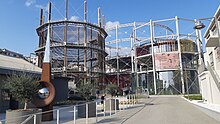
Climate change has caused an increase in Istanbul's heatwaves,[107] droughts,[108] storms,[109] and flooding[110][111] in Istanbul. Furthermore, as Istanbul is a large and rapidly expanding city, its urban heat island has been intensifying the effects of climate change.[112] If trends continue, sea level rise is likely to affect city infrastructure, for example Kadıkoy metro station is threatened with flooding.[113] Xeriscaping of green spaces has been suggested,[114] and Istanbul has a climate-change action plan,[115] but not a net zero target.[116]: 51
Flora and fauna

The natural vegetation of the province is made up of mixed broadleaf forest and pseudo-maquis, reflecting the city's transitional, Mediterranean-influenced humid temperate climate.[100] Chestnut, oak, elm, linden, ash and locust comprise the most prominent temperate forest genera, while laurel, terebinth, Cercis siliquastrum, broom, red firethorn, and oak species such as Quercus cerris and Quercus coccifera are the most important species of Mediterranean and Submediterranean distribution. Apart from the natural flora, Platanus orentalis, horse chestnut, cypress and stone pine make up the introduced species that got acclimatized to Istanbul.[117] In a study that examined urban flora in Kartal, a total of 576 plant taxa were recorded; of those 477 were natural and 99 were exotic and cultivated. The most prominent native taxa were in the Asteraceae family (50 species), while the most diverse exotic plant family was Rosaceae (16 species).[118]
Turkish Straits and Sea of Marmara play a vital role for migrating fish and other marine animals between Mediterranean, Marmara and Black Sea. Bosporus hosts pelagic, demersal and semipelagic fish species and more than 130 different taxa have been documented in the strait.[119] Bluefish, bonito, sea bass, horse mackerel and anchovies compose the economically important species. Fish diversity in the waters of Istanbul has dwindled in the recent decades. From around 60 different fish species recorded in the 1970s only 20 of them still survive in the Bosporus.[120][dubious – discuss] Common bottlenose dolphin (Turkish: afalina), short-beaked common dolphin (Turkish: tırtak) and harbor porpoise (Turkish: mutur) make up the marine mammals presently found in the Bosporus and surrounding waters, though since the 1950s the number of dolphin observations has become increasingly rare. Mediterranean monk seals were present in Bosporus, and Princes' Islands and Tuzla shores were seal breeding areas during summer, but they have not been observed in Istanbul since the 1960s and thought to be extinct in the region.[121] Water pollution, overfishing and destruction of coastal habitats caused by urbanization are main threats to Istanbul's marine ecology.
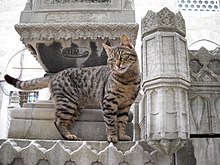
Apart from the wild land mammals Istanbul hosts a sizeable stray animal population. The presence of feral cats in Istanbul (Turkish: sokak kedisi) is noted to be very prevalent, with estimates ranging from a hundred thousand to over a million stray cats. The feral cats in the city have gained widespread media and public attention and are considered to be symbols of the city.[122][123] Rose-ringed parakeet colonies are present in urban areas, similar to other European cities as feral parrots, and considered as invasive species.[124]
Pollution
Air pollution in Turkey is acute in İstanbul with cars, buses and taxis causing frequent urban smog,[125] as it is one of the few European cities without a low-emission zone. As of 2019[update] the city's mean air quality remains at a level so as to affect the heart and lungs of healthy street bystanders during peak traffic hours,[126] and almost 200 days of pollution were measured by the air pollution sensors at Sultangazi, Mecidiyeköy, Alibeyköy and Kağıthane.[127] It is one of the 10 worst cities for NO
2.[128] However a trial of congestion pricing is planned for the historic peninsula.[129]
Algal blooms and red tides were reported in the Sea of Marmara and Bosporus (especially in Golden Horn), and regularly happen in urban lakes such as Lake Büyükçekmece and Küçükçekmece. In June 2021, a marine mucilage wave allegedly caused by water pollution spread to Sea of Marmara.[130]
Cityscape
Districts and neighborhoods
European side

The Fatih district, which was named after Mehmed II (Turkish: Fatih Sultan Mehmed), corresponds to what was the whole of Constantinople until the Ottoman conquest; today it is the capital district and called the historic peninsula of Istanbul on the southern shore of the Golden Horn, across the medieval Genoese citadel of Galata on the northern shore. The Genoese fortifications in Galata were largely demolished in the 19th century, leaving only the Galata Tower, to make way for the northward expansion of the city.[131] Galata (Karaköy) is today a quarter within the Beyoğlu district, which forms Istanbul's commercial and entertainment center and includes İstiklal Avenue and Taksim Square.[132]
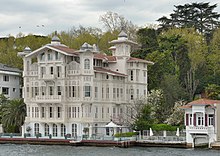
Dolmabahçe Palace, the seat of government during the late Ottoman period, is in the Beşiktaş district on the European shore of the Bosporus, to the north of Beyoğlu. The former village of Ortaköy is within Beşiktaş and gives its name to the Ortaköy Mosque on the Bosporus, near the Bosporus Bridge. Lining both the European and Asian shores of the Bosporus are the historic yalıs, luxurious chalet mansions built by Ottoman aristocrats and elites as summer homes.[133] Inland, north of Taksim Square is the Istanbul Central Business District, a set of corridors lined with office buildings, residential towers, shopping centers, and university campuses, and over 2,000,000 m2 (22,000,000 sq ft) of class-A office space in total. Maslak, Levent, and Bomonti are important nodes within the CBD.[134][135]
The Atatürk Airport corridor is another such edge city-style business, residential and shopping corridor with over 900,000 m2 (9,700,000 sq ft) of class-A office space.[135]
Asian side
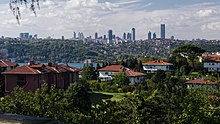
During the Ottoman period, Üsküdar (then Scutari) and Kadıköy were outside the scope of the urban area, serving as tranquil outposts with seaside yalıs and gardens. But in the second half of the 20th century, the Asian side experienced major urban growth; the late development of this part of the city led to better infrastructure and tidier urban planning when compared with most other residential areas in the city.[136] Much of the Asian side of the Bosporus functions as a suburb of the economic and commercial centers in European Istanbul, accounting for a third of the city's population but only a quarter of its employment.[136] However, Kozyatağı–Ataşehir, Altunizade, Kavacık and Ümraniye, all together having around 1.4 million sqm of class-A office space, are now important "edge cities", i.e. corridors and nodes of business and shopping centers and of tall residential buildings.[135]
Expansion
As a result of Istanbul's exponential growth in the 20th century, a significant portion of the city is composed of gecekondus (literally "built overnight"), referring to illegally constructed squatter buildings.[137] At present, some gecekondu areas are being gradually demolished and replaced by modern mass-housing compounds.[138] Moreover, large scale gentrification and urban renewal projects have been taking place,[139] such as the one in Tarlabaşı;[140] some of these projects, like the one in Sulukule, have faced criticism.[141] The Turkish government also has ambitious plans for an expansion of the city west and northwards on the European side in conjunction with the new Istanbul Airport, opened in 2019; the new parts of the city will include four different settlements with specified urban functions, housing 1.5 million people.[142]
Parks

Istanbul does not have a primary urban park, but it has several green areas. Gülhane Park and Yıldız Park were originally included within the grounds of two of Istanbul's palaces — Topkapı Palace and Yıldız Palace—but they were repurposed as public parks in the early decades of the Turkish Republic.[143] Another park, Fethi Paşa Korusu, is on a hillside adjacent to the Bosphorus Bridge in Anatolia, opposite Yıldız Palace in Europe.
Along the European side, and close to the Fatih Sultan Mehmet Bridge, is Emirgan Park, which was known as the Kyparades ('Cypress Forest') during the Byzantine period. In the Ottoman period, it was first granted to Nişancı Feridun Ahmed Bey in the 16th century, before being granted by Sultan Murad IV to the Safavid emir Gûne Han in the 17th century, hence the name Emirgan. The 47-hectare (120-acre) park was later owned by Khedive Isma'il Pasha of Ottoman Egypt in the 19th century. Emirgan Park is known for its diversity of plants and an annual tulip festival is held there since 2005.[144]
The AKP government's decision to replace Taksim Gezi Park with a replica of the Ottoman era Taksim Military Barracks (which was transformed into the Taksim Stadium in 1921, before being demolished in 1940 for building Gezi Park) sparked a series of nationwide protests in 2013 covering a wide range of issues.
Popular during the summer among Istanbulites is Belgrad Forest, spreading across 5,500 hectares (14,000 acres) at the northern edge of the city. The forest originally supplied water to the city and remnants of reservoirs used during Byzantine and Ottoman times survive.[145][146]
Architecture

Istanbul is primarily known for its Byzantine and Ottoman architecture. Despite its development as a Turkish city since 1923, it contains many ancient, Roman, Byzantine, Christian, Muslim, and Jewish monuments.
The Neolithic settlement in the Yenikapı quarter on the European side, which dates back to c. 6500 BCE and predates the formation of the Bosporus by approximately a millennium, when the Sea of Marmara was still a lake,[citation needed] was discovered during the construction of the Marmaray railway tunnel.[26] It is the oldest known human settlement on the European side of the city.[26] The oldest known human settlement on the Asian side is the Fikirtepe Mound near Kadıköy, with relics dating to the Chalcolithic period c. 5500 – c. 3500 BCE.
There are numerous ancient monuments in the city.[147] The most ancient is the Obelisk of Thutmose III (Obelisk of Theodosius).[147] Built of red granite, 31 m (100 ft) high, it came from the Temple of Karnak in Luxor, and was erected there by Pharaoh Thutmose III (r. 1479 – 1425 BCE) to the south of the seventh pylon.[147] The Roman emperor Constantius II (r. 337–361 CE– ) had it and another obelisk transported along the Nile to Alexandria for commemorating his ventennalia or 20 years on the throne in 357. The other obelisk was erected on the spina of the Circus Maximus in Rome in the autumn of that year, and is now known as the Lateran Obelisk. The obelisk that would become the Obelisk of Theodosius remained in Alexandria until 390, when Theodosius I (r. 379–395) had it transported to Constantinople and put up on the spina of the Hippodrome there.[148] When re-erected at the Hippodrome of Constantinople, the obelisk was mounted on a decorative base, with reliefs that depict Theodosius I and his courtiers.[147] The lower part of the obelisk was damaged in antiquity, probably during its transport to Alexandria in 357 CE or during its re-erection at the Hippodrome of Constantinople in 390 CE. As a result, the current height of the obelisk is only 18.54 meters, or 25.6 meters if the base is included. Between the four corners of the obelisk and the pedestal are four bronze cubes, used in its transportation and re-erection.[149]
Next in age is the Serpent Column, from 479 BCE.[147] It was brought from Delphi in 324 CE, during the reign of Constantine the Great, and also erected at the spina of the Hippodrome.[147] It was originally part of an ancient Greek sacrificial tripod in Delphi that was erected to commemorate the Greeks who fought and defeated the Persian Empire at the Battle of Plataea in 479 BCE. The three serpent heads of the 8-meter (26 ft) high column remained intact until the end of the 17th century (one is on display at the nearby Istanbul Archaeology Museums).[151]
Built in porphyry and erected at the center of the Forum of Constantine in 330 CE to mark the founding of the new Roman capital, the Column of Constantine was originally adorned with a sculpture of the Roman emperor Constantine the Great depicted as the solar god Apollo on its top, which fell in 1106 and was later replaced by a cross during the reign of Byzantine emperor Manuel Komnenos (r. 1143–1180).[17][147]
There are traces of the Byzantine era throughout the city, from ancient churches that were built over early Christian meeting places like the Hagia Irene, the Chora Church, the Monastery of Stoudios, the Church of Sts. Sergius and Bacchus, the Church of Theotokos Pammakaristos, the Monastery of the Pantocrator, the Monastery of Christ Pantepoptes, the Hagia Theodosia, the Church of Theotokos Kyriotissa, the Monastery of Constantine Lips, the Church of Myrelaion, the Hagios Theodoros, etc.; to palaces like the Great Palace of Constantinople and its Mosaic Museum, the Palace of the Porphyrogenitus, Boukoleon Palace and Palace of Blachernae; and other public places and buildings like the Hippodrome, the Augustaion, the Basilica Cistern, Theodosius Cistern, Cistern of Philoxenos and Cistern of the Hebdomon, the Aqueduct of Valens, the Prison of Anemas, the Walls of Constantinople and the Porta Aurea (Golden Gate), among numerous others. The 4th century Harbor of Theodosius in Yenikapı, once the busiest port in Constantinople, was among the numerous archeological discoveries that took place during the excavations of the Marmaray tunnel.[26]
However, it is the Hagia Sophia that fully conveys the period of Constantinople as a city without parallel in Christendom. The Hagia Sophia, topped by a dome 31 meters (102 ft) in diameter over a square space defined by four arches, is the pinnacle of Byzantine architecture.[152] The Hagia Sophia stood as the world's largest cathedral in the world until it was converted into a mosque in the 15th century.[152] The minarets date from that period.[152] Because of its historical significance, it was reopened as a museum in 1935. However, it was re-converted into a mosque in July 2020.
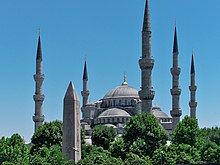
Over the next four centuries, the Ottomans transformed Istanbul's urban landscape with a vast building scheme that included the construction of towering mosques and ornate palaces. The Sultan Ahmed Mosque (Blue Mosque), another landmark of the city, faces the Hagia Sophia at Sultanahmet Square (Hippodrome of Constantinople). The Süleymaniye Mosque, built by Suleiman the Magnificent, was designed by his chief architect Mimar Sinan, the most illustrious of all Ottoman architects, who designed many of the city's renowned mosques and other types of public buildings and monuments.[154]
Among the oldest surviving examples of Ottoman architecture in Istanbul are the Anadoluhisarı and Rumelihisarı fortresses, which assisted the Ottomans during their siege of the city.[155] Over the next four centuries, the Ottomans made an indelible impression on the skyline of Istanbul, building towering mosques and ornate palaces.
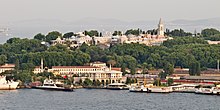
Topkapı Palace, dating back to 1465, is the oldest seat of government surviving in Istanbul. Mehmed II built the original palace as his main residence and the seat of government.[156] The present palace grew over the centuries as a series of additions enfolding four courtyards and blending neoclassical, rococo, and baroque architectural forms.[157] In 1639, Murad IV made some of the most lavish additions, including the Baghdad Kiosk, to commemorate his conquest of Baghdad the previous year.[158] Government meetings took place here until 1786, when the seat of government was moved to the Sublime Porte.[156] After several hundred years of royal residence, it was abandoned in 1853 in favor of the baroque Dolmabahçe Palace.[157] Topkapı Palace became public property following the abolition of monarchy in 1922.[157] After extensive renovation, it became one of Turkey's first national museums in 1924.[156]
The imperial mosques include Fatih Mosque, Bayezid Mosque, Yavuz Selim Mosque, Süleymaniye Mosque, Sultan Ahmed Mosque (the Blue Mosque), and Yeni Mosque, all of which were built at the peak of the Ottoman Empire, in the 16th and 17th centuries. In the following centuries, and especially after the Tanzimat reforms, Ottoman architecture was supplanted by European styles.[159] An example of which is the imperial Nuruosmaniye Mosque. Areas around İstiklal Avenue were filled with grand European embassies and rows of buildings in Neoclassical, Renaissance Revival and Art Nouveau styles, which went on to influence the architecture of a variety of structures in Beyoğlu—including churches, stores, and theaters—and official buildings such as Dolmabahçe Palace.[160]
Administration
Since 2004, the municipal boundaries of Istanbul have been coincident with the boundaries of its province.[161] The city, considered capital of the larger Istanbul Province, is administered by the Istanbul Metropolitan Municipality (IMM, Turkish: İstanbul Büyükşehir Belediyesi, IBB), which oversees the 39 districts of the city-province.
The current city structure can be traced back to the Tanzimat period of reform in the 19th century, before which Islamic judges and imams led the city under the auspices of the Grand Vizier. Following the model of French cities, this religious system was replaced by a mayor and a citywide council composed of representatives of the confessional groups (millet) across the city. Pera (now Beyoğlu) was the first area of the city to have its own director and council, with members instead being longtime residents of the neighborhood.[162] Laws enacted after the Ottoman constitution of 1876 aimed to expand this structure across the city, imitating the twenty arrondissements of Paris, but they were not fully implemented until 1908 when the city was declared a province with nine constituent districts.[163][164] This system continued beyond the founding of the Turkish Republic, with the province renamed a belediye (municipality), but the municipality was disbanded in 1957.[165]
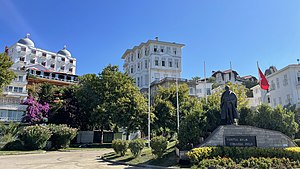
Small settlements adjacent to major population centers in Turkey, including Istanbul, were merged into their respective primary cities during the early 1980s, resulting in metropolitan municipalities.[166][167] The main decision-making body of the Istanbul Metropolitan Municipality is the Municipal Council, with members drawn from district councils.
The Municipal Council of Istanbul is responsible for citywide issues, including managing the budget, maintaining civic infrastructure, and overseeing museums and major cultural centers.[168] Since the government operates under a "powerful mayor, weak council" approach, the council's leader—the metropolitan mayor—has the authority to make swift decisions, often at the expense of transparency.[169] The Municipal Council is advised by the Metropolitan Executive Committee, although the committee also has limited power to make decisions of its own.[170] All representatives on the committee are appointed by the metropolitan mayor and the council, with the mayor—or someone of his or her choosing—serving as head.[170][171]
District councils are chiefly responsible for waste management and construction projects within their respective districts. They each maintain their own budgets, although the metropolitan mayor reserves the right to review district decisions. One-fifth of all district council members, including the district mayors, also represent their districts in the Municipal Council.[168] All members of the district councils and the Municipal Council, including the metropolitan mayor, are elected to five-year terms.[172] Representing the Republican People's Party, Ekrem İmamoğlu has been the Mayor of Istanbul since 27 June 2019.[173]
With the Istanbul Metropolitan Municipality and Istanbul Province having equivalent jurisdictions, few responsibilities remain for the provincial government. Like the MMI, the Istanbul Special Provincial Administration has a governor, a democratically elected decision-making body—the Provincial Parliament—and an appointed Executive Committee. Mirroring the executive committee at the municipal level, the Provincial Executive Committee includes a secretary-general and leaders of departments that advise the Provincial Parliament.[171][174] The Provincial Administration's duties are largely limited to the building and maintenance of schools, residences, government buildings, and roads, and the promotion of arts, culture, and nature conservation.[175] Davut Gül has been the Governor of Istanbul Province since 5 June 2023.[176]
Demographics

|
| |||||||||||||||||||||||||||||||||||||||||||||||||||||||||||||||||||||||||||||||||||||||||||||||||||||||||||||
| Sources: Jan Lahmeyer 2004,Chandler 1987, Morris 2010,Turan 2010[177] Pre-Republic figures estimated[f] | ||||||||||||||||||||||||||||||||||||||||||||||||||||||||||||||||||||||||||||||||||||||||||||||||||||||||||||||
Throughout most of its history, Istanbul has ranked among the largest cities in the world. By 500 CE, Constantinople had somewhere between 400,000 and 500,000 people, edging out its predecessor, Rome, for the world's largest city.[179] Constantinople jostled with other major historical cities, such as Baghdad, Chang'an, Kaifeng and Merv for the position of the world's largest city until the 12th century. It never returned to being the world's largest, but remained the largest city in Europe from 1500 to 1750, when it was surpassed by London.[180]
The Turkish Statistical Institute estimates that the population of Istanbul Metropolitan Municipality was 15,519,267 at the end of 2019, hosting 19 percent of the country's population.[181] 64.4% of the residents live on the European side and 35.6% on the Asian side.[181]
Istanbul ranks as the seventh-largest city proper in the world, and the second-largest urban agglomeration in Europe, after Moscow.[182][183] The city's annual population growth of 1.5 percent ranks as one of the highest among the seventy-eight largest metropolises in the Organisation for Economic Co-operation and Development. The high population growth mirrors an urbanization trend across the country, as the second and third fastest-growing OECD metropolises are the Turkish cities of İzmir and Ankara.[16]
Istanbul experienced especially rapid growth during the second half of the 20th century, with its population increasing tenfold between 1950 and 2000.[184] This growth was fueled by internal and international migration. Istanbul's foreign population with a residence permit increased dramatically, from 43,000 in 2007[185] to 856,377 in 2019.[186][187]
According to 2020 TÜİK data around 2.1 million people in a population of over 15.4 million have been registered[g] in Istanbul, meanwhile the vast majority of the residents ultimately originate from Anatolian provinces, especially those in the Black Sea, Central and Eastern Anatolia regions due to internal migration since the 1950s.[188] People registered in Kastamonu, Ordu, Giresun, Erzurum, Samsun, Malatya, Trabzon, Sinop and Rize provinces represent the biggest population groups in Istanbul, meanwhile people registered in Sivas has the highest percentage with more than 760 thousand residents in the city.[189] A 2019 survey found that only 36% of the Istanbul's population was born in the province.[190]
Ethnic and religious groups
Istanbul has been a cosmopolitan city throughout much of its history, but it has become more homogenized since the end of the Ottoman era. The dominant ethnic group in the city is Turkish people, which also forms the majority group in Turkey. According to survey data 78% of the voting-age Turkish citizens in Istanbul state "Turkish" as their ethnic identity.[190]
With estimates ranging from 2 to 4 million, Kurds form one of the largest ethnic minorities in Istanbul and are the biggest group after Turks among Turkish citizens.[191][192] According to a 2019 KONDA study, Kurds constituted around 17% of Istanbul's adult total population who were Turkish citizens.[190] Although the initial Kurdish presence in the city dates back to the early Ottoman period,[193] the majority of Kurds in the city originate from villages in eastern and southeastern Turkey.[194] Zazas are also present in the city and constitute around 1% of the total voting-age population.[190]
Arabs form the city's other largest ethnic minority, with an estimated population of more than 2 million.[195] Following Turkey's support for the Arab Spring, Istanbul emerged as a hub for dissidents from across the Arab world, including former presidential candidates from Egypt, Kuwaiti MPs, and former ministers from Jordan, Saudi Arabia (including Jamal Khashoggi), Syria, and Yemen.[196][197][198] As of August 2019, the number of refugees of the Syrian Civil War in Turkey residing in Istanbul was estimated to be around 1 million.[199] Native Arab population in Turkey who are Turkish citizens are found to be making up less than 1% of city's total adult population.[190] As of August 2023, there were more than 530,000 refugees of the Syrian civil war in Istanbul, the highest number in any Turkish city.[200]
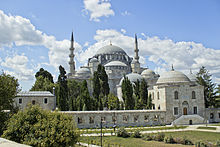
A 2019 survey study by KONDA that examined the religiosity of the voting-age adults in Istanbul showed that 57% of the surveyed had a religion and were trying to practise its requirements. This was followed by nonobservant people with 26% who identified with a religion but generally did not practise its requirements. 11% stated they were fully devoted to their religion, meanwhile 6% were non-believers who did not believe the rules and requirements of a religion. 24% of the surveyed also identified themselves as "religious conservatives". Around 90% of Istanbul's population are Sunni Muslims and Alevism forms the second biggest religious group.[190][201]
Into the 19th century, the Christians of Istanbul tended to be either Greek Orthodox, members of the Armenian Apostolic Church or Catholic Levantines.[202] Greeks and Armenians form the largest Christian population in the city. While Istanbul's Greek population was exempted from the 1923 population exchange with Greece, changes in tax status and the 1955 anti-Greek pogrom prompted thousands to leave.[203] Following Greek migration to the city for work in the 2010s, the Greek population rose to nearly 3,000 in 2019, still greatly diminished since 1919, when it stood at 350,000.[203] There are today 50,000 to 70,000 Armenians in Istanbul[204] down from a peak of 164,000 in 1913.[205] As of 2019, an estimated 18,000 of the country's 25,000 Christian Assyrians live in Istanbul.[206]

The majority of the Catholic Levantines (Turkish: Levanten) in Istanbul and İzmir are the descendants of traders/colonists from the Italian maritime republics of the Mediterranean (especially Genoa and Venice) and France, who obtained special rights and privileges called the Capitulations from the Ottoman sultans in the 16th century.[208] The community had more than 15,000 members during Atatürk's presidency in the 1920s and 1930s, but today is reduced to only a few hundreds, according to Italo-Levantine writer Giovanni Scognamillo.[209] They continue to live in Istanbul (mostly in Karaköy, Beyoğlu and Nişantaşı), and İzmir (mostly in Karşıyaka, Bornova and Buca).
Istanbul became one of the world's most important Jewish centers in the 16th and 17th century.[210] Romaniote and Ashkenazi communities existed in Istanbul before the conquest of Istanbul, but it was the arrival of Sephardic Jews that ushered a period of cultural flourishing. Sephardic Jews settled in the city after their expulsion from Spain and Portugal in 1492 and 1497.[210] Sympathetic to the plight of Sephardic Jews, Bayezid II sent out the Ottoman Navy under the command of admiral Kemal Reis to Spain in 1492 in order to evacuate them safely to Ottoman lands.[210] In marked contrast to Jews in Europe, Ottoman Jews were allowed to work in any profession.[211] Ottoman Jews in Istanbul excelled in commerce and came to particularly dominate the medical profession.[211] By 1711, using the printing press, books came to be published in Spanish and Ladino, Yiddish, and Hebrew.[212] In large part due to emigration to Israel, the Jewish population in the city dropped from 100,000 in 1950[213] to 15,000 in 2021.[214][215][216]
Politics
Politically, Istanbul is seen as the most important administrative region in Turkey. In the run-up to local elections in 2019, Erdoğan claimed 'if we fail in Istanbul, we will fail in Turkey'.[217] The contest in Istanbul carried deep political, economic and symbolic significance for Erdoğan, whose election of mayor of Istanbul in 1994 had served as his launchpad.[218] For Ekrem İmamoğlu, winning the mayoralty of Istanbul was a huge moral victory, but for Erdoğan it had practical ramifications: His party, AKP, lost control of the $4.8 billion municipal budget, which had sustained patronage at the point of delivery of many public services for 25 years.[219]

More recently, Istanbul and many of Turkey's metropolitan cities are following a trend away from the government and their right-wing ideology. In 2013 and 2014, large scale anti-AKP government protests began in İstanbul and spread throughout the nation. This trend first became evident electorally in the 2014 mayoral election where the center-left opposition candidate won an impressive 40% of the vote, despite not winning. The first government defeat in Istanbul occurred in the 2017 constitutional referendum, where Istanbul voted 'No' by 51.4% to 48.6%. The AKP government had supported a 'Yes' vote and won the vote nationally due to high support in rural parts of the country. A major turning point for the government came in the 2019 local elections, where their candidate for Mayor, former Prime Minister Binali Yıldırım, was defeated by a very narrow margin by the Republican People's Party candidate Ekrem İmamoğlu. İmamoğlu won the vote with 48.77% of the vote, against Yıldırım's 48.61%, but the elections were controversially annulled by the Supreme Electoral Council due to AKP's claim of electoral fraud. In the re-run İmamoğlu gathered 54.22% of the total vote and widened his margin of victory.[220]
Following the 2019 election, a trend towards the CHP has persisted across the city. In the 2023 presidential election the CHP candidate, Kemal Kılıçdaroğlu, received 48.56% of the city's vote, while the incumbent president and AKP candidate, Recep Tayyip Erdoğan, received 46.68%.
In the 2024 local elections, Ekrem İmamoğlu was re-elected by a 12-point margin. İmamoğlu won 51.15% of the vote, while the AKP's candidate Murat Kurum received 39.59%. Additionally, the CHP won the mayoralties in 26 of İstanbul's 39 districts.[221]
Administratively, Istanbul is divided into 39 districts, more than any other province in Turkey. Istanbul Province sends 98 Members of Parliament to the Grand National Assembly of Turkey, which has a total of 600 seats. For the purpose of parliamentary elections, Istanbul is divided into three electoral districts; two on the European side and one on the Asian side, electing 28, 35 and 35 MPs respectively.[citation needed]
Economy
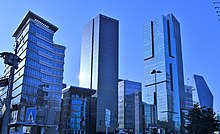
Istanbul had the eleventh-largest economy among the world's urban areas in 2018, and is responsible for 30 percent of Turkey's industrial output,[222] 31 percent of GDP,[222] and 47 percent of tax revenues.[222] The city's gross domestic product adjusted by PPP stood at US$537.507 billion in 2018,[223] with manufacturing and services accounting for 36 percent and 60 percent of the economic output respectively.[222] Istanbul's productivity is 110 percent higher than the national average.[222] Trade is economically important, accounting for 30 percent of the economic output in the city.[15] In 2019, companies based in Istanbul produced exports worth $83.66 billion and received imports totaling $128.34 billion; these figures were equivalent to 47 percent and 61 percent, respectively, of the national totals.[224]
Istanbul, which straddles the Bosporus strait, houses international ports that link Europe and Asia. The Bosporus, providing the only passage from the Black Sea to the Mediterranean, is the world's busiest and narrowest strait used for international navigation, with more than 200 million tons of oil passing through it each year.[225] International conventions guarantee passage between the Black and the Mediterranean seas,[226] even when tankers carry oil, natural gas, chemicals, and other flammable or explosive materials as cargo. In 2011, as a workaround solution, the then Prime Minister Erdoğan presented Canal Istanbul, a project to open a new strait between the Black and Marmara seas.[226] While the project was still on Turkey's agenda in 2020, there has not been a clear date set for it.[15]

Shipping is a significant part of the city's economy, with 73.9 percent of exports and 92.7 percent of imports in 2018 executed by sea.[15] Istanbul has three major shipping ports – the Port of Haydarpaşa, the Port of Ambarlı, and the Port of Zeytinburnu – as well as several smaller ports and oil terminals along the Bosporus and the Sea of Marmara.[15]
Haydarpaşa, at the southeastern end of the Bosporus, was Istanbul's largest port until the early 2000s.[227] Since then operations were shifted to Ambarlı, with plans to convert Haydarpaşa into a tourism complex.[15] In 2019, Ambarlı, on the western edge of the urban center, had an annual capacity of 3,104,882 TEUs, making it the third-largest cargo terminal in the Mediterranean basin.[227]
Istanbul has been an international banking hub since the 1980s,[15] and is home to the only active stock exchange in Turkey, Borsa Istanbul, which was originally established as the Ottoman Stock Exchange in 1866.[228]

In 1995, keeping up with the financial trends, Borsa Istanbul moved its headquarters (which was originally located on Bankalar Caddesi, the financial center of the Ottoman Empire,[228] and later at the 4th Vakıf Han building in Sirkeci) to İstinye, in the vicinity of Maslak, which hosts the headquarters of numerous Turkish banks.[229]
Since 2023, the Ataşehir district on the Asian side of the city is home to the Istanbul Financial Center (IFC), where the new headquarters of the state-owned Turkish banks, including the Turkish Central Bank, are located.[230][231] As of 2023, the five tallest skyscrapers in Istanbul and Turkey are the 352 m (1,154 ft 10 in) tall Turkish Central Bank Tower[232][233][234] in the Ataşehir district on the Asian side of the city; Metropol Istanbul Tower A (70 floors / 301 metres including its twin spires)[235][236] also in the Ataşehir district; Skyland Istanbul Towers 1 and 2 (2 x 284 metres)[237] located adjacent to Nef Stadium in the Huzur neighbourhood of the Sarıyer district on the European side, and Istanbul Sapphire (54 floors / 238 metres; 261 metres including its spire)[238] in Levent on the European side.
13.4 million foreign tourists visited the city in 2018, making Istanbul the world's fifth most-visited city in that year.[239] Istanbul and Antalya are Turkey's two largest international gateways, receiving a quarter of the nation's foreign tourists. Istanbul has more than fifty museums, with the Topkapı Palace, the most visited museum in the city, bringing in more than $30 million in revenue each year.[15]
Istanbul expects 1 million tourists from cruise companies after the renovation of its cruise port, also known as Galataport in Karaköy district.[240]
Culture
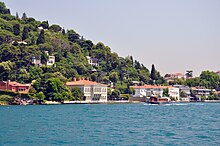
Istanbul was historically known as a cultural hub, but its cultural scene stagnated after the Turkish Republic shifted its focus toward Ankara.[243] The new national government established programs that served to orient Turks toward musical traditions, especially those originating in Europe, but musical institutions and visits by foreign classical artists were primarily centered in the new capital.[244]
Much of Turkey's cultural scene had its roots in Istanbul, and by the 1980s and 1990s Istanbul reemerged globally as a city whose cultural significance is not solely based on its past glory.[245]
By the end of the 19th century, Istanbul had established itself as a regional artistic center, with Turkish, European, and Middle Eastern artists flocking to the city. Despite efforts to make Ankara Turkey's cultural heart, Istanbul had the country's primary institution of art until the 1970s.[246] When additional universities and art journals were founded in Istanbul during the 1980s, artists formerly based in Ankara moved in.[247]

Beyoğlu has been transformed into the artistic center of the city, with young artists and older Turkish artists formerly residing abroad finding footing there. Modern art museums, including İstanbul State Art and Sculpture Museum, National Palaces Painting Museum, İstanbul Modern, the Pera Museum, Sakıp Sabancı Museum, Arter and SantralIstanbul, opened in the 2000s to complement the exhibition spaces and auction houses that have already contributed to the cosmopolitan nature of the city.[249] These museums have yet to attain the popularity of older museums on the historic peninsula, including the Istanbul Archaeology Museums, which ushered in the era of modern museums in Turkey, and the Turkish and Islamic Arts Museum.[248]
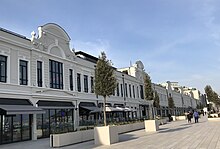
The first film screening in Turkey was at Yıldız Palace in 1896, a year after the technology publicly debuted in Paris.[250] Movie theaters rapidly cropped up in Beyoğlu, with the greatest concentration of theaters being along the street now known as İstiklal Avenue.[251] Istanbul also became the heart of Turkey's nascent film industry, although Turkish films were not consistently developed until the 1950s.[252] Since then, Istanbul has been the most popular location to film Turkish dramas and comedies.[253] The Turkish film industry ramped up in the second half of the century, and with Uzak (2002) and My Father and My Son (2005), both filmed in Istanbul, the nation's movies began to see substantial international success.[254] Istanbul and its picturesque skyline have also served as a backdrop for several foreign films, including From Russia with Love (1963), Topkapi (1964), The World Is Not Enough (1999), and Mission Istaanbul (2008).[255]
Coinciding with this cultural reemergence was the establishment of the Istanbul Festival, which began showcasing a variety of art from Turkey and around the world in 1973. From this flagship festival came the International Istanbul Film Festival and the Istanbul Jazz Festival in the early 1980s. With its focus now solely on music and dance, the Istanbul Festival has been known as the Istanbul International Music Festival since 1994.[256] The most prominent of the festivals that evolved from the original Istanbul Festival is the Istanbul Biennial, held every two years since 1987. Its early incarnations were aimed at showcasing Turkish visual art, and it has since opened to international artists and risen in prestige to join the elite biennales, alongside the Venice Biennale and the São Paulo Art Biennial.[257]
Leisure and entertainment

Abdi İpekçi Street in Nişantaşı, Galataport Shopping Area in Karaköy and Bağdat Avenue on the Anatolian side of the city have evolved into high-end shopping districts.[258][259] Other focal points for shopping, leisure and entertainment include Nişantaşı, Ortaköy, Bebek and Kadıköy.[260] The city has numerous shopping centers, from the historic to the modern. Istanbul also has an active nightlife and historic taverns, a signature characteristic of the city for centuries, if not millennia.
The Grand Bazaar, in operation since 1461, is among the world's oldest and largest covered markets.[261][262] Mahmutpasha Bazaar is an open-air market extending between the Grand Bazaar and the Spice Bazaar, which has been Istanbul's major spice market since 1660.
Galleria Ataköy ushered in the age of modern shopping malls in Turkey when it opened in 1987.[263] Since then, malls have become major shopping centers outside the historic peninsula. Akmerkez was awarded the titles of "Europe's best" and "World's best" shopping mall by the International Council of Shopping Centers in 1995 and 1996; Istanbul Cevahir has been one of the continent's largest since opening in 2005; and Kanyon won the Cityscape Architectural Review Award in the Commercial Built category in 2006.[262] Zorlu Center and İstinye Park are among the other upscale malls in Istanbul which include the stores of the world's top fashion brands.

Along İstiklal Avenue is the Çiçek Pasajı ('Flower Passage'), a 19th-century shopping gallery which is today home to winehouses (known as meyhanes), pubs and restaurants.[264] İstiklal Avenue, originally known for its taverns, has shifted toward shopping, but the nearby Nevizade Street is still lined with winehouses and pubs.[265][266] Some other neighborhoods around İstiklal Avenue have been revamped to cater to Beyoğlu's nightlife, with formerly commercial streets now lined with pubs, cafes, and restaurants playing live music.[267]

Istanbul is known for its historic seafood restaurants. Many of the city's most popular and upscale seafood restaurants line the shores of the Bosporus (particularly in neighborhoods like Ortaköy, Bebek, Arnavutköy, Yeniköy, Beylerbeyi and Çengelköy). Kumkapı along the Sea of Marmara has a pedestrian zone that hosts around fifty fish restaurants.[268]
The Princes' Islands, 15 kilometers (9 mi) from the city center, are also popular for their seafood restaurants. Because of their restaurants, historic summer mansions, and tranquil, car-free streets, the Princes' Islands are a popular vacation destination among Istanbulites and foreign tourists.[269]
Istanbul is also famous for its sophisticated and elaborately-cooked dishes of the Ottoman cuisine. Following the influx of immigrants from southeastern and eastern Turkey, which began in the 1960s, the city's foodscape has drastically changed by the end of the century; with influences of Middle Eastern cuisine such as kebab taking an important place in the food scene.
Restaurants featuring foreign cuisines are mainly concentrated in the Beyoğlu, Beşiktaş, Şişli and Kadıköy districts.
Apart from the city's numerous stadiums, sports halls and concert halls, there are several open-air venues for concerts and festivals, such as the Cemil Topuzlu Open-Air Theatre in Harbiye, Paraf Kuruçeşme Open-Air on the Bosphorus shore in Kuruçeşme, and Parkorman in the forest of Maslak. The annual Istanbul Jazz Festival has been held every year since 1994. Organized between 2003 and 2013, Rock'n Coke was the biggest open-air rock festival in Turkey, sponsored by Coca-Cola. It was traditionally held at the Hezarfen Airfield in Istanbul.

The Istanbul International Music Festival has been held annually since 1973, and the International Istanbul Film Festival has been held annually since 1982. The Istanbul Biennial is a contemporary art exhibition that has been held biennially since 1987. The Istanbul Shopping Fest is an annual shopping festival held since 2011, and Teknofest is an annual festival of aviation, aerospace and technology, held since 2018.
When it was held for the first time in 2003, the annual Istanbul Pride became the first gay pride event in a Muslim-majority country.[270] Since 2015, all types of parades at Taksim Square and İstiklal Avenue (where, in 2013, the Gezi Park protests took place) have been denied permission by the AKP government, citing security concerns, but hundreds of people have defied the ban each year. Critics have claimed that the bans were in fact due to ideological reasons.
Sports
Istanbul is home to some of Turkey's oldest sports clubs. Beşiktaş J.K., established in 1903, is considered the oldest of these sports clubs. Due to its initial status as Turkey's only club, Beşiktaş occasionally represented the Ottoman Empire and Turkish Republic in international sports competitions, earning the right to place the Turkish flag inside its team logo.[271] Galatasaray S.K. and Fenerbahçe S.K. have fared better in international competitions and have won more Süper Lig titles, at 22 and 19 times, respectively.[272][273][274] Galatasaray and Fenerbahçe have a long-standing rivalry, with Galatasaray based in the European part and Fenerbahçe based in the Anatolian part of the city.[273] Istanbul has seven basketball teams—Anadolu Efes, Beşiktaş, Darüşşafaka, Fenerbahçe, Galatasaray, İstanbul Büyükşehir Belediyespor and Büyükçekmece—that play in the premier-level Basketbol Süper Ligi.[275]
Many of Istanbul's sports facilities have been built or upgraded since 2000 to bolster the city's bids for the Summer Olympic Games. Atatürk Olympic Stadium, the largest multi-purpose stadium in Turkey, was completed in 2002 as an IAAF first-class venue for track and field.[276] The stadium hosted the 2005 UEFA Champions League Final, and was selected by the UEFA to host the CL Final games of 2020 and 2021, which were relocated to Lisbon (2020) and Porto (2021) due to the COVID-19 pandemic.[277] Şükrü Saracoğlu Stadium, Fenerbahçe's home field, hosted the 2009 UEFA Cup Final three years after its completion. Türk Telekom Arena opened in 2011 to replace Ali Sami Yen Stadium as Galatasaray's home turf,[278][279] while Vodafone Park, opened in 2016 to replace BJK İnönü Stadium as the home turf of Beşiktaş, hosted the 2019 UEFA Super Cup game. All four stadiums are elite Category 4 (formerly five-star) UEFA stadiums.[h]
The Sinan Erdem Dome, among the largest indoor arenas in Europe, hosted the final of the 2010 FIBA World Championship, the 2012 IAAF World Indoor Championships, as well as the 2011–12 Euroleague and 2016–17 EuroLeague Final Fours.[283] Prior to the completion of the Sinan Erdem Dome in 2010, Abdi İpekçi Arena was Istanbul's primary indoor arena, having hosted the finals of EuroBasket 2001.[284] Several other indoor arenas, including the Beşiktaş Akatlar Arena, have also been inaugurated since 2000, serving as the home courts of Istanbul's sports clubs. The most recent of these is the 13,800-seat Ülker Sports Arena, which opened in 2012 as the home court of Fenerbahçe's basketball teams.[285] Despite the construction boom, five bids for the Summer Olympics—in 2000, 2004, 2008, 2012, and 2020—and national bids for UEFA Euro 2012 and UEFA Euro 2016 have ended unsuccessfully.[286]
The TVF Burhan Felek Sport Hall is one of the major volleyball arenas in the city and hosts clubs such as Eczacıbaşı VitrA, Vakıfbank SK, and Fenerbahçe who have won numerous European and World Championship titles.[citation needed]
Between the 2005–2011 seasons,[287] and in the 2020 season,[288] Istanbul Park racing circuit hosted the Formula One Turkish Grand Prix. The 2021 F1 Turkish Grand Prix was initially cancelled due to the COVID-19 pandemic,[289] but on 25 June 2021, it was announced that the 2021 F1 Turkish Grand Prix will take place on 3 October 2021.[290] Istanbul Park was also a venue of the World Touring Car Championship and the European Le Mans Series in 2005 and 2006, but the track has not seen either of these competitions since then.[291][292] It also hosted the Turkish Motorcycle Grand Prix between 2005 and 2007. Istanbul was occasionally a venue of the F1 Powerboat World Championship, with the last race on the Bosporus strait on 12–13 August 2000.[293][unreliable source?] The last race of the Powerboat P1 World Championship on the Bosporus took place on 19–21 June 2009.[294] Istanbul Sailing Club, established in 1952, hosts races and other sailing events on the waterways in and around Istanbul each year.[295][296]
Media
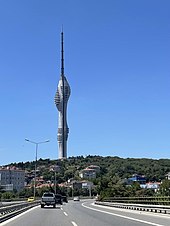
Most state-run radio and television stations are based in Ankara, but Istanbul is the primary hub of Turkish media. The industry has its roots in the former Ottoman capital, where the first Turkish newspaper, Takvim-i Vekayi (Calendar of Affairs), was published in 1831. The Cağaloğlu street on which the newspaper was printed, Bâb-ı Âli Street, rapidly became the center of Turkish print media, alongside Beyoğlu across the Golden Horn.[298]
Istanbul now has a wide variety of periodicals. Most nationwide newspapers are based in Istanbul, with simultaneous Ankara and İzmir editions.[299] Hürriyet, Sabah, Posta and Sözcü, the country's top four papers, are all headquartered in Istanbul, boasting more than 275,000 weekly sales each.[300] Hürriyet's English-language edition, Hürriyet Daily News, has been printed since 1961, but the English-language Daily Sabah, first published by Sabah in 2014, has overtaken it in circulation. Several smaller newspapers, including popular publications like Cumhuriyet, Milliyet and Habertürk are also based in Istanbul.[299] Istanbul also has long-running Armenian language newspapers, notably the dailies Marmara and Jamanak and the bilingual weekly Agos in Armenian and Turkish.[301]
Radio broadcasts in Istanbul date back to 1927, when Turkey's first radio transmission came from atop the Central Post Office in Eminönü. Control of this transmission, and other radio stations established in the following decades, ultimately came under the state-run Turkish Radio and Television Corporation (TRT), which held a monopoly on radio and television broadcasts between its founding in 1964 and 1990.[302] Today, TRT runs four national radio stations; these stations have transmitters across the country so each can reach over 90 percent of the country's population, but only Radio 2 is based in Istanbul. Offering a range of content from educational programming to coverage of sporting events, Radio 2 is the most popular radio station in Turkey.[302] Istanbul's airwaves are the busiest in Turkey, primarily featuring either Turkish-language or English-language content. One of the exceptions, offering both, is Açık Radyo (94.9 FM). Among Turkey's first private stations, and the first featuring foreign popular music, was Istanbul's Metro FM (97.2 FM). The state-run Radio 3, although based in Ankara, also features English-language popular music, and English-language news programming is provided on NTV Radyo (102.8 FM).[303]
TRT-Children is the only TRT television station based in Istanbul.[304] Istanbul is home to the headquarters of several Turkish stations and regional headquarters of international media outlets. Istanbul-based Star TV was the first private television network to be established following the end of the TRT monopoly; Star TV and Show TV (also based in Istanbul) remain highly popular throughout the country, airing Turkish and American series.[305] Kanal D and ATV are other stations in Istanbul that offer a mix of news and series; NTV (partnered with American media outlet MSNBC) and Sky Turk—both based in the city—are mainly just known for their news coverage in Turkish. The BBC has a regional office in Istanbul, assisting its Turkish-language news operations, and the American news channel CNN established the Turkish-language CNN Türk there in 1999.[306]
Education

As of 2019, excluding universities more than 3.1 million students attended 7,437 schools in Istanbul, about half of the schools being private schools.[307] The average class size was 30 for primary education institutes, 27 for vocational schools and 23 for general high schools.[307] Of the 842 public high schools, 263 are vocational schools, another 263 are Anatolian high schools, 207 are religiously oriented İmam Hatip schools, and 14 are STEM-oriented science high schools.[308] Galatasaray High School was established in 1481 and is the oldest public high school in Turkey.[309] Kabataş Erkek Lisesi, Istanbul Lisesi and Cağaloğlu Anatolian High School are among other public high schools in the city. Istanbul also contains high schools established by the European and American expatriates and missionaries in the 19th century that currently offer secular, foreign-language education such as Robert College, Deutsche Schule Istanbul, Sankt Georgs-Kolleg, Lycée Saint-Joseph and Liceo Italiano di Istanbul.[310] Furthermore Turkish citizens of Jewish, Armenian, Greek and Assyrian descent are allowed to establish and attend their respective schools as granted in the Treaty of Lausanne, Phanar Greek Orthodox College being an example.[311] Most high schools are highly selective and demand high scores from the national standardized LGS exam [tr] for admission, with Galatasaray and Robert College only accepting the top 0.1% to 0.01% of the exam takers.[312]
Istanbul contains almost a third of all universities in Turkey. As of 2019 Istanbul has 61 colleges and universities, with more than 1.8 million students enrolled according to official figures. Of those, fourteen are state-owned, 44 are "foundation-owned" private universities and three are foundation-owned vocational universities of higher education. There are also military academies, including the Turkish Air Force Academy and Turkish Naval Academy as well as four foundation-owned vocational universities of higher education which are not affiliated with any university.[313]
Some of the most renowned and highly ranked universities in Turkey are in Istanbul. Istanbul University, the nation's oldest institute of higher education, dates back to 1453 and its dental, law, medical schools were founded in the 19th century.The city's largest private universities include Sabancı University, with its main campus in Tuzla, Koç University in Sarıyer, Özyeğin Üniversitesi near Altunizade. Istanbul's first private university, Koç University, was founded as late as 1992, because private universities were not allowed in Turkey before the 1982 amendment to the constitution.[309] Istanbul is also home to several conservatories and art schools, including Mimar Sinan Academy of Fine Arts, founded in 1882.[314]
Public universities with a major presence in the city, such as Istanbul University, Istanbul Technical University (the world's third-oldest university dedicated entirely to engineering, established in 1773), and Boğaziçi University (formerly the higher education section of Robert College until 1971) provide education in English as the primary foreign language, while the primary foreign language of education at Galatasaray University is French.[309]
Public services
Istanbul's first water supply systems date back to the city's early history, when aqueducts (such as the Valens Aqueduct) deposited the water in the city's numerous cisterns.[315] At the behest of Suleiman the Magnificent, the Kırkçeşme water supply network was constructed; by 1563, the network provided 4,200 cubic meters (150,000 cu ft) of water to 158 sites each day.[315] In later years, in response to increasing public demand, water from various springs was channeled to public fountains, like the Fountain of Ahmed III, by means of supply lines.[316] Today, Istanbul has a chlorinated and filtered water supply and a sewage treatment system managed by the Istanbul Water and Sewerage Administration (İstanbul Su ve Kanalizasyon İdaresi, İSKİ).[317]
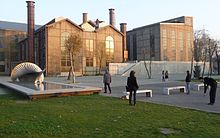
The Silahtarağa Power Station, a coal-fired power station along the Golden Horn, was the sole source of Istanbul's electricity between 1914, when its first engine room was completed, and 1952.[318] Following the founding of the Turkish Republic, the plant underwent renovations to accommodate the city's increasing demand; its capacity grew from 23 megawatts in 1923 to a peak of 120 megawatts in 1956.[318][319] Capacity declined until the power station reached the end of its economic life and shut down in 1983.[318] The state-run Turkish Electrical Authority (TEK) briefly—between its founding in 1970 and 1984—held a monopoly on the generation and distribution of electricity, but now the authority—since split between the Turkish Electricity Generation Transmission Company (TEAŞ) and the Turkish Electricity Distribution Company (TEDAŞ)—competes with private electric utilities.[319]
The Ottoman Ministry of Post and Telegraph was established in 1840 and the first post office, the Imperial Post Office, opened near the courtyard of Yeni Mosque. By 1876, the first international mailing network between Istanbul and the lands beyond the Ottoman Empire had been established.[320] Sultan Abdülmecid I issued Samuel Morse his first official honor for the electrical telegraph in 1847, and construction of the first telegraph line—between Istanbul and Edirne—finished in time to announce the end of the Crimean War in 1856.[321]

A nascent telephone system began to emerge in Istanbul in 1881 and after the first manual telephone exchange became operational in Istanbul in 1909, the Ministry of Post and Telegraph became the Ministry of Post, Telegraph, and Telephone.[320][323] GSM cellular networks arrived in Turkey in 1994, with Istanbul among the first cities to receive the service.[324] Today, mobile and landline service is provided by private companies, after Türk Telekom, which split from the Ministry of Post, Telegraph, and Telephone in 1995, was privatized in 2005.[320][324] Postal services remain under the purview of what is now the Post and Telegraph Organization (retaining the acronym PTT).[320]
In 2000, Istanbul had 137 hospitals, of which 100 were private.[325][needs update] Turkish citizens are entitled to subsidized healthcare in the nation's state-run hospitals.[299] As public hospitals tend to be overcrowded or otherwise slow, private hospitals are preferable for those who can afford them. Their prevalence has increased significantly over the last decade, as the percentage of outpatients using private hospitals increased from 6 percent to 23 percent between 2005 and 2009.[299][326] Many of these private hospitals, as well as some of the public hospitals, are equipped with high-tech equipment, including MRI machines, or associated with medical research centers.[327] Turkey has more hospitals accredited by the United States–based Joint Commission than any other country in the world, with most concentrated in its big cities. The high quality of healthcare, especially in private hospitals, has contributed to a recent upsurge in medical tourism to Turkey (with a 40 percent increase between 2007 and 2008).[328] Laser eye surgery and hair transplant surgery is particularly common among medical tourists, as Turkey is known for specializing in the procedure.[329]
Transportation
Roads
Istanbul's motorways network are the O-1, O-2, O-3, O-4 and O-7. The total length of Istanbul Province's network of toll roads is 543 km (337 mi) (2023) and the state highways network (devlet yollari) is 353 km (219 mi) (2021), totaling 896 km (557 mi) of expressway roads (minimum 2x2 lanes), excluding secondary roads and urban streets.[330][331][332] The density of expressway network is 16.8 km/100 km2. The O-1 forms the city's inner ring road, traversing the Bosphorus Bridge, and the O-2 is the city's outer ring road, crossing the Fatih Sultan Mehmet Bridge. The O-2 continues west to Edirne and the O-4 continues east to Ankara. The O-2, O-3, and O-4 are part of European route E80 (the Trans-European Motorway) between Portugal and the Iran–Turkey border.[333] In 2011, the first and second bridges on the Bosphorus carried 400,000 vehicles each day.[334] The O-7[332] or Kuzey Marmara Otoyolu, is a motorway that bypass Istanbul to the north. The O-7 motorway from Kinali Gişeleri to Istanbul Park Service has 139.2 km (86.5 mi), with 8 lanes (4x4), and from Odayeri-K10 to Istanbul Atatürk Airport has 30.4 km (18.9 mi).[332] The completed section of highway crosses the Bosporus via the Yavuz Sultan Selim (Third Bosphorus) Bridge, entered service on 26 August 2016.[335] The O-7 motorway connects Istanbul Atatürk Airport with Istanbul Airport. Environmentalist groups worry that the third bridge will endanger the remaining green areas to the north of Istanbul.[336][337] Apart from the three Bosphorus Bridges, the dual-deck, 14.6-kilometer (9.1 mi) Eurasia Tunnel (which entered service on 20 December 2016) under the Bosphorus strait also provides road crossings for motor vehicles between the Asian and European sides of Turkey.[338] Road transport emits significant carbon dioxide, estimated at 7 million tons in 2021.[339]
Public transportation
Istanbul's local public transportation system is a network of commuter rail, trams, funiculars, metro lines, buses, bus rapid transit, and ferries. Fares across modes are integrated, using the contactless Istanbulkart, introduced in 2009, or the older Akbil electronic ticketing device.[340] Trams in Istanbul date back to 1872, when they were horse-drawn, but even the first electrified trams were decommissioned in the 1960s.[341] Operated by Istanbul Electricity, Tramway and Tunnels General Management (İETT), trams slowly returned to the city in the 1990s with the introduction of the Istanbul nostalgic tram and a faster modern tram line, which now carries 265,000 passengers each day.[341][342] The Tünel opened in 1875 as the world's second-oldest subterranean rail line, after the Metropolitan Railway in London.[341] It still carries passengers between Karaköy and İstiklal Avenue along a steep 573-meter (1,880 ft) track; a more modern funicular between Taksim Square and Kabataş began running in 2006.[343][344]
The Istanbul Metro comprises ten lines (the M1, M2, M3, M6, M7, M9 and M11 on the European side, and the M4, M5 and M8 on the Asian side) with several other lines (M12 and M14) and extensions under construction.[345][346] The two sides of Istanbul's metro are connected under the Bosphorus by the Marmaray Tunnel, inaugurated in 2013 as the first rail connection between Thrace and Anatolia, having 13.5 km (8.4 mi) length.[347] The Marmaray tunnel together with the suburban railways lines along the Sea of Marmara, form the intercontinental commuter rail line in Istanbul, named officially B1, from Halkalı on the European side to Gebze on the Asian side. This rail line has 76.6 km (47.6 mi), and the full line opened on 12 March 2019.[348] Until then, buses provide transportation within and between the two-halves of the city, accommodating 2.2 million passenger trips each day.[349] The Metrobus, a form of bus rapid transit, crosses the Bosphorus Bridge, with dedicated lanes leading to its termini.[350]
Ferries
There are three main ferry operators in Istanbul. The municipally-owned Şehir Hatları operates the traditional vapur ferries on 891 daily trips between 53 piers across the Bosporus and the Princes' Islands[351]
The privately owned İDO (Istanbul Sea Buses) runs a combination of high-speed passenger ferries and vehicle ferries within Istanbul and to destinations across the Sea of Marmara.[352] A smaller private company, Turyol also operates services across the Bosphorus. The city's main cruise ship terminal is the Port of Istanbul in Karaköy, with a capacity of 10,000 passengers per hour.[353]
Railroads

International rail service from Istanbul launched in 1889, with a line between Bucharest and Istanbul's Sirkeci Terminal, which ultimately became famous as the eastern terminus of the Orient Express from Paris.[75] Regular service to Bucharest and Thessaloniki continued until the early 2010s, when the former was interrupted for Marmaray construction but started running again in 2019 and the latter was halted due to economic problems in Greece.[355][356] After Istanbul's Haydarpaşa Terminal opened in 1908, it served as the western terminus of the Baghdad Railway and an extension of the Hejaz Railway; today, neither service is offered directly from Istanbul.[357][358][359] Service to Ankara and other points across Turkey is normally offered by Turkish State Railways, but the construction of Marmaray and the Ankara-Istanbul high-speed railway forced the station to close in 2012.[360] New stations to replace both the Haydarpaşa and Sirkeci terminals, and connect the city's disjointed railway networks, now the Marmaray second phase opened to the public.[360] Private bus companies still operation to this day. Istanbul's main bus station is the largest in Europe, with a daily capacity of 15,000 buses and 600,000 passengers, serving destinations as distant as Frankfurt.[361][362]
Airports
Istanbul has had three large international airports, two of which currently serve commercial passenger flights. The largest is the new Istanbul Airport, opened in 2018 in the Arnavutköy district to the northwest of the city center, on the European side, near the Black Sea coast.
All scheduled commercial passenger flights were transferred from Atatürk Airport to Istanbul Airport on 6 April 2019, following the closure of Istanbul Atatürk Airport for scheduled passenger flights.[363] The IATA code IST was also transferred to the new airport.[364] Once all phases are completed in 2025, the airport will have six sets of runways (eight in total), 16 taxiways, and will be able to accommodate 200 million passengers a year.[365][366] The transfer from the airport to the city is via the O-7, and it will eventually be linked by two lines of the Istanbul Metro.
Sabiha Gökçen International Airport, 45 kilometers (28 mi) southeast of the city center, on the Asian side, was opened in 2001 to relieve Atatürk. Dominated by low-cost carriers, Istanbul's second airport has rapidly become popular, especially since the opening of a new international terminal in 2009;[367] the airport handled 14.7 million passengers in 2012, a year after Airports Council International named it the world's fastest-growing airport.[368][369] Atatürk had also experienced rapid growth, as its 20.6 percent rise in passenger traffic between 2011 and 2012 was the highest among the world's top 30 airports.[370]
Istanbul Atatürk Airport, located 24 kilometers (15 mi) west of the city center, on the European side, near the Marmara Sea coast, was formerly the city's largest airport. After its closure to commercial flights in 2019, it was briefly used by cargo aircraft and the official state aircraft owned by the Turkish government, until the demolition of its runway began in 2020. It handled 61.3 million passengers in 2015, which made it the third-busiest airport in Europe and the 18th-busiest in the world in that year.[370]
International relations
See also
- List of people from Istanbul
- Outline of Istanbul
- 1766 Istanbul earthquake
- Caput Mundi
- List of cities with the most skyscrapers
Notes
- ^ İstanbul Province = 5,460.85 km2
Land area = 5,343.22 km2
Lake/Dam = 117.63 km2
Europe (25 districts) = 3,474.35 km2
Asia (14 districts) = 1,868.87 km2
Urban (36 districts) = 2,576.85 km2 [Metro (39 districts) – (Çatalca+Silivri+Şile)]
* According to the size of the population and the status of megacity, the limits of the Istanbul city correspond to the limits of the province, and the province is treated like as the metropolitan-city of Istanbul. - ^ English pronunciation: /ˌɪstænˈbʊl/ IST-an-BUUL,[7][8] US also /ˈɪstænbʊl/ IST-an-buul; Turkish: İstanbul (Turkish pronunciation: [isˈtanbuɫ] , colloquial Turkish pronunciation: [ɯsˈtambuɫ])
- ^ Istanbul straddles both Europe and Asia, with its commercial and historical centre and two-thirds of the population in Europe, the rest in Asia. Since Istanbul is a transcontinental city, Moscow is the largest city entirely within Europe.
- ^ [isˈtanbuɫ]
- ^ The foundation of Byzantion (Byzantium) is sometimes, especially in encyclopedic or other tertiary sources, placed firmly in 667 BCE. Historians have disputed the precise year the city was founded. Commonly cited is the work of 5th-century-BCE historian Herodotus, which says the city was founded seventeen years after Chalcedon,[34] which came into existence around 685 BCE. Eusebius concurs with 685 BCE as the year Chalcedon was founded, but places Byzantion's establishment in 659 BCE.[35] Among more modern historians, Carl Roebuck proposed the 640s BCE[36] and others have suggested even later. The foundation date of Chalcedon is itself subject to some debate; while many sources place it in 685 BC,[37] others put it in 675 BCE[38] or even 639 BCE (with Byzantion's establishment placed in 619 BCE).[35] Some sources refer to Byzantium's foundation as the 7th century BCE.
- ^ Jump up to: a b Historians disagree—sometimes substantially—on population figures of Istanbul (Constantinople), and other world cities, prior to the 20th century. A follow-up to Chandler & Fox 1974,Chandler 1987, pp. 463–505[72] examines different sources' estimates and chooses the most likely based on historical conditions; it is the source of most population figures between 100 and 1914. The ranges of values between 500 and 1000 are due to Morris 2010, which also does a comprehensive analysis of sources, including Chandler (1987); Morris notes that many of Chandler's estimates during that time seem too large for the city's size, and presents smaller estimates. Chandler disagrees with Turan 2010 on the population of the city in the mid-1920s (with the former suggesting 817,000 in 1925), but Turan, p. 224, is used as the source of population figures between 1924 and 2005. Turan's figures, as well as the 2010 figure,[178] come from the Turkish Statistical Institute. The drastic increase in population between 1980 and 1985 is largely due to an enlargement of the city's limits (see the Administration section). Explanations for population changes in pre-Republic times can be inferred from the History section.
- ^ Based on state register data, which is unchangeable and inherited from the family. A married women is also registered to her husband's province.
- ^ UEFA does not apparently keep a list of Category 4 stadiums, but regulations stipulate that only these elite stadiums are eligible to host UEFA Champions League Finals,[280] which Atatürk Olympic Stadium did in 2005, and UEFA Europa League (formerly UEFA Cup) Finals,[281] which Şükrü Saracoğlu Stadium did in 2009. Türk Telekom Arena is noted as an elite UEFA stadium by its architects.[282]
References
- ^ "YETKİ ALANI". Istanbul Buyuksehir Belediyesi. Archived from the original on 6 April 2020. Retrieved 4 February 2020.
- ^ "İstanbul'un En Yüksek Tepeleri". Hava Forumu. Hava Durumu Forumu. 15 April 2020.
- ^ Jump up to: a b "The Results of Address Based Population Registration System, 2023". www.tuik.gov.tr. Turkish Statistical Institute. 6 February 2024. Retrieved 6 February 2024.
- ^ "Ulusal Hesaplar - Kişi başına GSYH ($)" [National Accounts - GDP per capita ($)]. www.tuik.gov.tr (in Turkish). Turkish Statistical Institute. Retrieved 8 December 2023.
- ^ "GDP by Provinces, 2022 - İstanbul had the highest share of GDP with 30.4% (Tables 1 and 3)". www.tuik.gov.tr. Turkish Statistical Institute. 7 December 2023. Retrieved 8 December 2023.
- ^ "Sub-national HDI – Area Database – Global Data Lab". hdi.globaldatalab.org.
- ^ Wells, John C. (2008). Longman Pronunciation Dictionary (3rd ed.). Longman. ISBN 978-1-4058-8118-0.
- ^ Upton, Clive; Kretzschmar, William A. Jr. (2017). The Routledge Dictionary of Pronunciation for Current English (2nd ed.). Routledge. p. 704. ISBN 978-1-138-12566-7.
- ^ Herrin, Judith (28 September 2009). Byzantium: The Surprising Life of a Medieval Empire. Princeton University Press. p. 5. ISBN 978-0-691-14369-9.
- ^ Jump up to: a b c d e "Istanbul". Encyclopædia Britannica. 3 October 2023.
- ^ Mango, Cyril (1991). "Constantinople". In Kazhdan, Alexander (ed.). The Oxford Dictionary of Byzantium. Oxford and New York: Oxford University Press. pp. 508–512. ISBN 0-19-504652-8.
- ^ Сталь 1993 , с. хв.
- ^ Jump up to: а б Мастерс и Агостон 2009 , стр. 114–15
- ^ «Рейтинг 100 лучших городских направлений 2023 года: раскрыты триумфы и потрясения» . Евромонитор Интернэшнл . 11 декабря 2023 г. Проверено 12 декабря 2023 г.
- ^ Jump up to: а б с д и ж г час я дж к л м н Хепер, Метин (2018). "Стамбул". Исторический словарь Турции (4-е изд.). Лэнхэм, доктор медицины: Роуман и Литтлфилд. ISBN 978-1-5381-0224-4 .
- ^ Jump up to: а б Территориальные обзоры ОЭСР: Стамбул, Турция . Политические обзоры. Организация экономического сотрудничества и развития . Март 2008 г. ISBN. 978-92-64-04383-1 .
- ^ Jump up to: а б с «Форум Константина» . www.byzantium1200.com . Проверено 31 января 2021 г.
- ^ Jump up to: а б с д Комната 2006 , с. 177
- ^ Георгакас 1947 , с. 352 и далее.
- ^ Неджипоглу 2010 , с. 262.
- ^ Недждет Сакаоглу (1993/94a): «Имена Стамбула»]. В: Стамбульская энциклопедия от прошлого к настоящему , под ред. Министерство культуры Турции, Стамбул.
- ^ Гросвенор, Эдвин Огастес (1895). Константинополь . Том. 1. Братья Робертс. п. 69 . Проверено 15 марта 2021 г.
- ^ Финкель 2005 , стр. 57, 383.
- ^ Гёксель и Керслейк 2005 , с. 27.
- ^ Кейдер 1999 , с. 95.
- ^ Jump up to: а б с д и Рейнсфорд, Сара (10 января 2009 г.). «Раскопано древнее прошлое Стамбула» . www.bbc.com . Би-би-си . Проверено 29 мая 2021 г.
- ^ Алган, О.; Ялчин, МНК; Оздоган, М.; Йылмаз, ЮК; Сари, Э.; Кырджи-Элмас, Э.; Йылмаз И.; Булкан, О.; Онган, Д.; Газиоглу, К.; Назик, А.; Полат, Массачусетс; Мерич, Э. (2011). «Голоценовые изменения побережья в древней гавани Еникапы-Стамбул и их влияние на историю культуры». Четвертичные исследования . 76 (1): 30. Бибкод : 2011QuRes..76...30A . дои : 10.1016/j.yqres.2011.04.002 . ISSN 0033-5894 . S2CID 129280217 .
- ^ «Это открытие меняет историю» . hurriyet.com.tr . 3 октября 2008 г.
- ^ «История открылась во время раскопок Мармарая» . fotogaleri.hurriyet.com.tr .
- ^ «Культурные детали Стамбула» . Турецкая Республика, министр культуры и туризма. Архивировано из оригинала 12 сентября 2007 года . Проверено 2 октября 2007 г.
- ^ Джанин, Раймонд (1964). Византийский Константинополь . Париж: Французский институт византийских исследований. стр. 10 ff.
- ^ «Плиний Старший, книга IV, глава XI:
« Покинув Дарданеллы, мы приходим к Касфенскому заливу... и мысу Золотого Рога, на котором находится город Византия, свободное государство, прежде называвшееся Лигосом; он находится в 711 милях от Дураццо ... " " Архивировано . 1 января 2017 года Проверено 21 июня 2015 года . - ^ Блум и Блэр 2009 , с. 1.
- ^ Геродота Истории 4.144, переведено в De Sélincourt 2003 , стр. 288
- ^ Jump up to: а б Исаак 1986 , с. 199.
- ^ Робак 1959 , с. 119, также как упоминалось у Исаака 1986 , с. 199
- ^ Листер 1979 , с. 35.
- ^ Свободно 1996 , с. 10.
- ^ Сталь 1993 , с. 11.
- ^ Де Соуза 2003 , с. 88.
- ^ Свободно 1996 , с. 20.
- ^ Свободно 1996 , с. 22.
- ^ Грант 1996 , стр. 8–10.
- ^ Лимберис 1994 , стр. 11–12.
- ^ Барнс 1981 , с. 77
- ^ Барнс 1981 , с. 212
- ^ Jump up to: а б Барнс 1981 , с. 222
- ^ Jump up to: а б Григорий 2010 , с. 63
- ^ Климчук и Уорнер 2009 , стр. 171.
- ^ Дэш, Майк (2 марта 2012 г.). «Синий против зеленого: раскачивание Византийской империи» . Смитсоновский журнал . Смитсоновский институт. Архивировано из оригинала 5 августа 2012 года . Проверено 30 июля 2012 г.
- ^ Дамус 1995 , с. 117
- ^ Кантор 1994 , с. 226
- ^ Моррис 2010 , стр. 109–18.
- ^ Парри, Кен (2009). Христианство: Религии мира . Издательство информационной базы. п. 139. ИСБН 9781438106397 .
- ^ Парри, Кен (2010). Блэквеллский компаньон восточного христианства . Джон Уайли и сыновья. п. 368. ИСБН 9781444333619 .
- ^ Грегори 2010 , стр. 324–29.
- ^ Грегори 2010 , стр. 330–333.
- ^ Грегори 2010 , с. 340.
- ^ Грегори 2010 , стр. 341–342.
- ^ «Деисусная мозаика» . Собор Святой Софии ноября 5 Получено 31 января.
- ^ Рейнерт 2002 , стр. 258–260.
- ^ Бэйнс 1949 , с. 47.
- ^ Грегори 2010 , стр. 394–399.
- ^ Бехар 1999 , с. 38.
- ^ Биделе и Джеффрис 1998 , с. 71.
- ^ Инальчик, Халил. «Политика Мехмеда II в отношении греческого населения Стамбула и византийских построек города». Документы Думбартон-Оукса 23, (1969): 229–49. п. 236
- ^ Холт, Ламбтон и Льюис 1977 , стр. 306–07.
- ^ Jump up to: а б Хьюз, Беттани (2018). Стамбул: Повесть о трех городах . Лондон: Вайденфельд и Николсон. ISBN 978-1-78022-473-2 .
- ^ Jump up to: а б Мэдден, Томас Ф. (7 ноября 2017 г.). Стамбул: Величественный город на перекрестке мира . Нью-Йорк: Книги Пингвина. ISBN 978-0-14-312969-1 .
- ^ Jump up to: а б с д и Бирн, Джозеф Патрик (2012). Энциклопедия Черной смерти . Санта-Барбара, Калифорния: ABC-Clio . ISBN 978-1-59884-253-1 .
- ^ Холт, Ламбтон и Льюис 1977 , стр. 735–36.
- ^ Jump up to: а б Чендлер, Терциус; Фокс, Джеральд (1974). 3000 лет роста городов . Лондон: Академическая пресса. ISBN 978-0-12-785109-9 .
- ^ Шоу и Шоу 1977 , стр. 4–6, 55.
- ^ Челик 1993 , стр. 87–89
- ^ Jump up to: а б Хартер 2005 , с. 251
- ^ Шоу и Шоу 1977 , стр. 230, 287, 306.
- ^ Челик, Зейнеп (1986). Переделка Стамбула: портрет османского города девятнадцатого века . Беркли. Лос-Анджелес. Лондон: Издательство Калифорнийского университета. п. 37.
- ^ «Меклис-и Мебусан (Ассамблея депутатов)» . Исторические события .
- ^ Сталь 1993 , с. 31
- ^ Фридман, Джери (2009). Геноцид армян (1-е изд.). Нью-Йорк: Паб Rosen. Группа. стр. 21–22. ISBN 978-1-4042-1825-3 .
- ^ Глобализация, космополитизм и дёнме в Османских Салониках и турецком Стамбуле . Марк Баер, Калифорнийский университет, Ирвайн.
- ^ «Вехи в истории Стамбульской фондовой биржи» . www.borsaistanbul.com . Проверено 31 января 2021 г.
- ^ Jump up to: а б «Освобождение Стамбула 6 октября» (на турецком языке). Пресс-секретарь . 6 октября 2017 г.
- ^ Ландау 1984 , с. 50
- ^ Дампер и Стэнли 2007 , с. 39
- ^ Агыр, Семь; Артунч, Джихан (2019). «Налог на богатство 1942 года и исчезновение немусульманских предприятий в Турции». Журнал экономической истории . 79 (1): 201–243. дои : 10.1017/S0022050718000724 . S2CID 159425371 .
- ^ Кейдер 1999 , стр. 11–12, 34–36.
- ^ Efe & Cürebal 2011 , стр. 718–719.
- ^ «Замкнутые и ползущие сегменты разломов у Стамбула» . www.gfz-potsdam.de . 4 августа 2023 г. Проверено 4 апреля 2024 г.
- ^ Jump up to: а б «Турция восстанавливается после одного землетрясения и готовится к новому» . Экономист . 5 декабря 2020 г. Проверено 14 декабря 2020 г.
- ^ «64-процентная вероятность того, что землетрясение в Стамбуле произойдет до 2030 года: эксперт» . Хюрриет Дейли Ньюс . 4 марта 2022 г. Проверено 9 февраля 2023 г.
- ^ «Опасность землетрясения в Стамбуле» . www.eskp.de. Проверено 31 марта 2024 г.
- ^ «Управление землетрясений и геотехнических исследований» . depremzemin.ibb.istanbul . Проверено 31 марта 2024 г.
- ^ «Фонд гуманитарной помощи İHH» . Фонд гуманитарной помощи İHH . Проверено 31 марта 2024 г.
- ^ «Землетрясение в Турции является предупреждением для Стамбула, который столкнется с еще большим количеством смертей в результате землетрясения» .
- ^ «600 000 квартир рухнут в результате сильного землетрясения в Стамбуле, - говорит министр» . Газета Дувар (на турецком языке). 8 февраля 2023 г. Проверено 31 марта 2024 г.
- ^ «Опасения по поводу землетрясения играют важную роль в предвыборной гонке за пост мэра Стамбула» . Экономист . ISSN 0013-0613 . Проверено 31 марта 2024 г.
- ^ EFE, Агентство (5 февраля 2024 г.). «Готов ли Стамбул к большому землетрясению?» . Новости EFE . Проверено 31 марта 2024 г.
- ^ «Жители Стамбула обеспокоены надвигающимся землетрясением: опрос - Türkiye News» . Хюрриет Дейли Ньюс . 28 марта 2024 г. Проверено 31 марта 2024 г.
- ^ Jump up to: а б Климатология 2 . Министерство окружающей среды и лесного хозяйства.
- ^ Аббасния, Мохсен; Торос, Хусейн; Мемариан, Хади (2019). «Анализ климата мегаполиса Стамбул на основе индекса биоклиматического комфорта человека» . Журнал исследований в области атмосферных наук . 1 (1). ISSN 0000-0000 .
- ^ «Снег на побережьях Средиземного моря» . www.nimbus.it . Проверено 28 апреля 2021 г.
- ^ «В некоторых районах Стамбула глубина снежного покрова достигла 85 сантиметров» . www.birgun.net .
- ^ «Официальная статистика» . mgm.gov.tr. Главное управление метеорологии. Архивировано из оригинала 23 декабря 2020 года . Проверено 13 декабря 2020 г.
- ^ «Rivista Ligure di Meteorologia 44 — Снег на побережьях Средиземного моря» . www.nimbus.it . Проверено 3 июня 2021 г.
- ^ «Климатические нормы Всемирной метеорологической организации на 1991-2020 годы» . Национальное управление океанических и атмосферных исследований . Проверено 16 января 2024 г.
- ^ «Турция оправилась от жары в Африке» . Ежедневный Сабах . 2 июля 2017 г.
- ^ «Правительство вынуждено принять меры на фоне количества осадков ниже среднего по Турции» . Хюрриет Дейли Ньюс . 21 января 2018 г.
- ^ «Молния электризует небо Стамбула на северо-западе Турции, когда наступают грозы» . Ежедневный Сабах . 24 июля 2018 г.
- ^ «Наводнение в Стамбуле — результат изменения климата в Турции» . Агентство Анадолу. 27 июля 2017 г.
- ^ Шен, Омер Лютфи. «Изменение климата в Турции» . Программа стипендий Меркатора – IPC = . Проверено 27 сентября 2018 г.
- ^ «Глобальная климатология в Стамбуле / Ататюрк – Инфоклимат» . www.infoclimat.fr . Проверено 28 апреля 2021 г.
- ^ «Температура в Турции через 30 лет значительно повысится из-за глобального потепления, - предупреждает эксперт по климату» . Хюрриет Дейли Ньюс . 19 марта 2018 г.
- ^ Четин, Нефисе; Мансуроглу, Сибель; Калайджи Онач, Айше (2018). «Осуществимость ксерискейпа как метода городской адаптации к глобальному потеплению: пример Турции» . Пол. Дж.Энвирон. шпилька . 27 (3): 1009–18. дои : 10.15244/pjoes/76678 .
- ^ «Стамбульский план действий по изменению климата» . Архивировано из оригинала 17 апреля 2019 года . Проверено 22 апреля 2019 г.
- ^ «Подведение итогов Net Zero 2023» . Чистый нулевой трекер . Проверено 11 ноября 2023 г. [ постоянная мертвая ссылка ]
- ^ «Босфор как наше культурное наследие» (PDF) . Архивировано из оригинала (PDF) 22 июля 2011 года.
- ^ Алтай, Волкан; Оумл, Брахим Лкер; зииит; Ярчи, Джелал (31 января 2010 г.). «Городская флора и экологические характеристики района Картал (Стамбул): вклад в городскую экологию Турции».
- ^ Артюз М.Л. (1999) Инвентаризация существующих видов и их мест обитания в районе Босфора . Морской биоабс., 1:112–023.
- ^ «Цели предотвращения загрязнения морской среды» . Управление водоснабжения и канализации Стамбула . Архивировано из оригинала 22 июля 2011 года.
- ^ «Рыба в Стамбуле». Стамбульская энциклопедия от прошлого к настоящему . II . Стамбул: Исторический фонд.
- ^ «Почему в Стамбуле так много бездомных кошек?» . Новости Би-би-си . Проверено 31 июля 2021 г.
- ^ Брейди, Тара. «Как уличные коты Стамбула встали на ноги» . Ирландские Таймс . Проверено 31 июля 2021 г.
- ^ «Инвазионные зеленые попугаи предупреждают в Стамбуле: их численность превысила 5-6 тысяч, городская фауна может быть нарушена» . birgun.net (на турецком языке) . Проверено 31 июля 2021 г.
- ^ «Надоело стамбульское движение» . 20 февраля 2017 г. Проверено 28 сентября 2018 г.
- ^ «Понимание автомобильного загрязнения – AQI, вредные последствия и как его уменьшить?» . Новости18 . 1 марта 2019 года.
- ^ Черный отчет 2020: Загрязнение воздуха и последствия для здоровья [Черный отчет 2020: Загрязнение воздуха и последствия для здоровья] (Отчет) (на турецком языке). Платформа «Право на чистый воздух» Турция . Август 2020.
- ^ Харви, Фиона (17 августа 2022 г.). «Крупные города страдают от загрязнения диоксидом азота, показывают исследования | Загрязнение воздуха» . Хранитель . Проверено 1 октября 2022 г.
- ^ «Муниципалитет Стамбула запускает программу устойчивого транспорта» . Газета Дувар . 14 декабря 2023 г. Проверено 7 мая 2024 г.
- ^ « Вспышка «морских соплей» у берегов Турции представляет угрозу для морской жизни» . Рейтер . 1 июня 2021 г. Проверено 31 июля 2021 г.
- ^ Челик 1993 , стр. 70, 169
- ^ Сталь 1993 , с. 127
- ^ Мунан, Венди (29 октября 1999 г.). «Для турок искусство отметить 700-летие» . Нью-Йорк Таймс . Проверено 4 июля 2012 г.
- ^ Оксфордская бизнес-группа 2009 , с. 105.
- ^ Jump up to: а б с Общий обзор рынка офисной недвижимости Стамбула: третий квартал 2021 г. (PDF) (отчет). Опора В. стр. 3, 9.
- ^ Jump up to: а б Общество WCTR и Унью Сейсаку Кенкю Кико 2004 , стр. 281.
- ^ Карпат 1976 , стр. 78–96
- ^ Явуз, Эркан (8 июня 2009 г.). «Правительство запускает план борьбы с незаконным строительством» . Сегодняшний Заман . Архивировано из оригинала 20 января 2012 года . Проверено 20 декабря 2011 г.
- ^ Аткинсон, Роуленд; Бридж, Гэри (2005). Джентрификация в глобальном контексте: новый городской колониализм . Рутледж. стр. 123–. ISBN 978-0-415-32951-4 . Проверено 6 мая 2013 г.
- ^ Бурк, Джессика (4 июля 2012 г.). «Бедным, но гордым районам Стамбула грозит джентрификация» . Нью-Йорк Таймс . Проверено 6 мая 2013 г.
- ^ Тейт, Роберт (22 июля 2008 г.). «План принудительного джентрификации означает конец старого цыганского района Стамбула» . Хранитель . Проверено 6 мая 2013 г.
- ^ «Строительство нового города начнется через шесть месяцев» . Hurriyet Daily News . 22 февраля 2013 года . Проверено 6 мая 2013 г.
- ^ Бояр и Флот 2010 , с. 247
- ^ Тейлор 2007 , с. 241
- ^ «Системы водоснабжения, резервуары, благотворительные и бесплатные фонтаны, турецкие бани» . Министерство культуры и туризма Турецкой Республики. Архивировано из оригинала 19 ноября 2010 года . Проверено 29 апреля 2012 г.
- ^ Путеводители по тайм-ауту, 2010 , с. 212
- ^ Jump up to: а б с д и ж г Палата архитекторов Турции 2006 , стр. 80, 118.
- ^ Лабиб Хабачи , Обелиски Египта, небоскребы прошлого , Американский университет в Каире, 1985, стр.145-151.
- ^ EA Уоллис Бадж , Иглы Клеопатры и другие египетские обелиски , Общество религиозных трактатов, Лондон, 1926, перепечатано в 1990 году, стр. 160-165.
- ^ «Преемственность и изменения в Стамбуле девятнадцатого века: султан Абдулазиз и дворец Бейлербейи», Филиз Енишехирлиоглу, Исламское искусство в XIX веке: традиции, инновации и эклектика , 65.
- ^ Официальный сайт губернатора Стамбула — Змеиная колонна . Веб-страница. Архивировано 2 августа 2007 г. в Wayback Machine.
- ^ Jump up to: а б с Манго, Кирилл (1985). Византийская архитектура . Милан: Электа Эдитрис. ISBN 978-0-8478-0615-7 .
- ^ «Голубая мечеть» . bluemosque.co . Проверено 12 июня 2014 г.
- ^ Jump up to: а б «Синан, османский архитектор» . Британская энциклопедия . 8 апреля 2024 г.
- ^ Свободно 2000 , с. 283
- ^ Jump up to: а б с Свободно 2011 г.
- ^ Jump up to: а б с Уортон, Элисон (2015). Архитекторы Османского Константинополя . ИБ Таурис. ISBN 978-1-78076-852-6 .
- ^ Нечипоглу, Гюльру (2005). Эпоха Синана: архитектурная культура Османской империи . Принстон: Издательство Принстонского университета. ISBN 978-0-691-12326-4 .
- ^ Сталь 1993 , с. 159
- ^ Челик 1993 , стр. 133–34, 141
- ^ «Метрополитенское муниципальное право». Великое Национальное Собрание Турции (на турецком языке). 10 июля 2004 г. Архивировано из оригинала 1 апреля 2015 г. Проверено 30 ноября 2010 г.
В день вступления в силу настоящего Закона; Границы столичного муниципалитета — это гражданские границы провинций в провинциях Стамбул и Коджаэли. (На дату вступления в силу этого закона границы мегаполисов в провинциях Стамбул и Коджаэли являются границами провинций.)
- ^ Роуз 2012 , стр. 43–49
- ^ Челик 1993 , стр. 42–48
- ^ Капуджу и Палабийик 2008 , с. 145
- ^ Ташан-Кок 2004 , с. 87
- ^ Винн 1984 , с. 188
- ^ Ташан-Кок 2004 , стр. 87–88
- ^ Jump up to: а б Капуджу и Палабийик 2008 , стр. 101-1. 153–55
- ^ Эрдер, Сема (ноябрь 2009 г.). «Местное самоуправление в Стамбуле» (PDF) . Стамбул: Город перекрестков . Городской век. Лондон: 46. Архивировано из оригинала (PDF) 29 августа 2017 года . Проверено 16 июля 2012 г.
- ^ Jump up to: а б Капуджу и Палабийик 2008 , с. 156
- ^ Jump up to: а б «Столичный исполнительный комитет» . Муниципалитет Стамбула. Архивировано из оригинала 2 января 2012 года . Проверено 21 декабря 2011 г.
- ^ Капуку и Палабийик 2008 , стр. 107-1. 155–56
- ^ «Мэр» . Муниципалитет Стамбула. Архивировано из оригинала 12 июля 2018 года . Проверено 12 июля 2018 г. «Мэр» . Муниципалитет Стамбула. Архивировано из оригинала 15 июля 2019 года . Проверено 20 ноября 2020 г.
- ^ «Организация» [Организация] (на турецком языке). Специальная провинциальная администрация Стамбула. Архивировано из оригинала 26 ноября 2011 года . Проверено 21 декабря 2011 г.
- ^ Организация экономического сотрудничества и развития 2008 , с. 206
- ^ «Стамбул Валиси Давут Гюль» . Губернаторство Стамбула . Проверено 7 июня 2024 г.
- ^ «Население Стамбула в Турции с 2007 по 2019 год» . Статистика.
- ^ «Итоги адресной системы регистрации населения за 2010 год» (документ) . Турецкий статистический институт. 28 января 2011 года . Проверено 24 декабря 2011 г.
- ^ Моррис 2010 , с. 113
- ^ Чендлер 1987 , стр. 463–505.
- ^ Jump up to: а б «Итоги адресной системы регистрации населения, 2019 год» . data.tuik.gov.tr. Стамбул, Турция: Türkiye İstatistik Kurumu. 4 февраля 2020 г. Проверено 12 декабря 2020 г.
- ^ «Часто задаваемые вопросы» . Перспективы мировой урбанизации, редакция 2011 года . Организация Объединенных Наций. 5 апреля 2012 года. Архивировано из оригинала 7 сентября 2012 года . Проверено 20 сентября 2012 г.
- ^ «Файл 11a: 30 крупнейших городских агломераций, ранжированных по численности населения в каждый момент времени, 1950–2035 гг.» (xls) . Перспективы мировой урбанизации, редакция 2018 года . Организация Объединенных Наций. 5 апреля 2012 года . Проверено 21 августа 2018 г.
- ^ Туран 2010 , с. 224
- ^ Камп, Кристина (17 февраля 2010 г.). «Стартапы в Турции: организованность эмигрантов» . Сегодняшний Заман . Архивировано из оригинала 9 мая 2013 года . Проверено 27 марта 2012 г.
- ^ «Статистика международной миграции, 2019» . data.tuik.gov.tr. Стамбул, Турция: Türk İstatistik Kurumu. 17 июля 2020 г. Проверено 12 декабря 2020 г.
- ^ Мир, Фергюс (29 ноября 2020 г.). «Городская статистика: Стамбул против Афин» . Файнэншл Таймс . Проверено 12 декабря 2020 г.
- ^ Мурат, Седат. «Население Стамбула и внутренние миграции по местам рождения» .
- ^ Рассвет, Новый (11 февраля 2021 г.). «Откуда больше всего людей? В каком городе в Стамбуле проживает больше всего граждан?» . Йени Шафак (на турецком языке) . Проверено 22 сентября 2021 г.
- ^ Jump up to: а б с д и ж «Анализ избирательных урн и кластеры избирателей, 23 июня 2019 г.» (PDF) . КОНДА .
- ^ Мустафа Мохамед Карадаги (1995). Справочник курдской организации Human Rights Watch, Inc: некоммерческой гуманитарной организации . ООН.
- ^ Тирман, Джон (1997). Военные трофеи: человеческая цена американской торговли оружием . Свободная пресса. ISBN 978-0-684-82726-1 .
- ^ Мастерс и Агостон 2009 , стр. 520–21
- ^ Басер, Бахар; Тойванен, Мари; Зорлу, Бегум; Думан, Ясин (6 ноября 2018 г.). Методологические подходы в курдских исследованиях: теоретические и практические выводы с мест . Лексингтонские книги. п. 87. ИСБН 978-1-4985-7522-5 .
- ^ МакКернан, Бетан (18 апреля 2020 г.). «Как Стамбул вернул себе корону сердца мусульманского мира» . Хранитель . Проверено 11 декабря 2020 г.
- ^ Лепеска, Дэвид (27 декабря 2013 г.). «Стамбул: маловероятное убежище для изгнанных журналистов» . Атлантика . Проверено 11 декабря 2020 г.
- ^ Хаббард, Бен (14 апреля 2019 г.). «Арабские изгнанники свободно звучат в Стамбуле, хотя Турция заглушает своих собственных критиков» . Нью-Йорк Таймс . Проверено 11 декабря 2020 г.
- ^ «Почему диссиденты собираются в Стамбуле» . Экономист . 11 октября 2018 года . Проверено 11 декабря 2020 г.
- ^ «Сирийским мигрантам в Турции грозит крайний срок покинуть Стамбул» . Новости Би-би-си . 20 августа 2019 г. Проверено 28 января 2021 г.
- ^ «Количество сирийцев в Турции в июле 2023 г. – Ассоциация беженцев» . multeciler.org.tr .
- ^ «Созлюк» . Конда Интерактив . Архивировано из оригинала 27 сентября 2021 года . Проверено 22 сентября 2021 г.
- ^ Сталь 1993 , с. 38
- ^ Jump up to: а б Магра, Илиана (5 ноября 2020 г.). «Греки в Стамбуле внимательно следят за развитием событий» . www.ekathimerini.com . Экатимерини . Проверено 1 декабря 2020 г.
- ^ Турай, Анна. «Тарихте Эрменилер» . Болсохайс: Стамбульские армяне. Архивировано из оригинала 6 декабря 2006 года . Проверено 4 января 2007 г.
- ^ Григорян, Илиана. «Армянские трудовые мигранты в Стамбуле» (PDF) . Университет Коч . Проверено 1 декабря 2020 г.
- ^ DHA, Daily Sabah (10 января 2019 г.). «Ассирийская община снова процветает на юго-востоке Турции» . Ежедневный Сабах . Проверено 20 мая 2020 г.
- ^ Хепер, Метин (2018). Исторический словарь Турции (Четвертое изд.). Лэнхэм, Северная Дакота: Издательство Rowman & Littlefield. п. 211. ИСБН 978-1-5381-0224-4 .
- ^ Левантийское историческое наследие
- ^ Интервью с Джованни Сконьямилло
- ^ Jump up to: а б с Эпштейн, Марк Алан (1980). Османские еврейские общины и их роль в пятнадцатом и шестнадцатом веках . Фрайбург: К. Шварц. ISBN 978-3-87997-077-3 .
- ^ Jump up to: а б Маковецкий, Лия (1989). Средиземноморье и евреи . Рамат-Ган: Издательство Университета Бар-Илан. стр. 75–104. ISBN 978-965-226-099-4 .
- ^ Насси, Гад (2010). Еврейская журналистика и типографии в Османской империи и современной Турции . Пискатауэй, Нью-Джерси: Gorgias Press. ISBN 978-1-61719-909-7 .
- ^ Соломон, Норман (2015). Исторический словарь иудаизма (Третье изд.). Лэнхэм, Мэриленд: Издательство Rowman & Littlefield. ISBN 978-1-4422-4141-1 .
- ^ «Виртуальный тур по еврейской истории Турции - Еврейская виртуальная библиотека» . jewishvirtuallibrary.org . Проверено 9 октября 2016 г.
- ^ «Почему евреи в охваченной террором Турции еще не бегут в Израиль» . Гаарец . haaretz.com . Проверено 9 октября 2016 г.
- ^ Еврейское население по странам, 2021 г.
- ^ «Эрдоган: «Если мы оступимся в Стамбуле, мы оступимся и в Турции» » . Теле1 . 2 апреля 2019 года . Проверено 4 мая 2019 г.
- ^ Инглби, Мелвин (14 июня 2019 г.). «Лидер турецкой оппозиции борется с Эрдоганом с «радикальной любовью» » . Атлантика . Проверено 14 декабря 2020 г.
- ^ Питель, Лаура (24 июня 2019 г.). «Поражение Эрдогана в Стамбуле свидетельствует об изменении тактики оппозиции» . Файнэншл Таймс . Проверено 14 декабря 2020 г.
- ^ Исил Сариюце и Ивана Коттасова. «Повторные выборы в Стамбуле могут выиграть оппозиция, что станет ударом по Эрдогану» . CNN .
- ^ «Сечим 2024» . secim.aa.com.tr . Проверено 4 апреля 2024 г.
- ^ Jump up to: а б с д и Обзор регионов и городов ОЭСР, 2020 год . Издательство ОЭСР. 2020. doi : 10.1787/959d5ba0-en . ISBN 978-92-64-58785-4 . S2CID 240715488 . Проверено 1 декабря 2020 г.
- ^ «Краткий обзор регионов и городов Турции в 2018 году» (PDF) . Организация экономического сотрудничества и развития . Издательство ОЭСР . Проверено 2 декабря 2020 г.
- ^ «Торговая статистика Турции» . Всемирный банк . Проверено 1 декабря 2020 г.
- ^ Оксфордская бизнес-группа 2009 , с. 112.
- ^ Jump up to: а б Джонс, Сэм (27 апреля 2011 г.). «Новый Босфорский канал в Стамбуле «превзойдет Суэц или Панаму» . Хранитель . Проверено 2 декабря 2020 г.
- ^ Jump up to: а б «Морская разведка в порту Амбарлы» . Список Ллойда, морская разведка . Страховые услуги Ллойда. 24 августа 2020 г. Проверено 2 декабря 2020 г.
- ^ Jump up to: а б «Общее наследие Имперского Османского банка تراث مشترك» . Heritage.bnf.fr . Библиотеки Востока . Проверено 2 декабря 2020 г.
- ^ «nBorsa Istanbul: История трансформации» (PDF) . borsaistanbul.com . Биржа Стамбула . Проверено 2 декабря 2020 г.
- ^ Туба Онгун (17 апреля 2023 г.). «Стамбульский финансовый центр открывается открытием банковского отдела» . Агентство Анадолу .
- ^ «Стамбульский финансовый центр: недвижимость» . ifm.gov.tr. Проверено 13 мая 2023 г.
- ^ «Центральный банк Турецкой Республики» . skyscraperpage.com . Проверено 20 мая 2023 г.
- ^ «Центральный банк Турецкой Республики» . skyscrapercenter.com . Проверено 20 мая 2023 г.
- ^ «Кампус Центрального банка Турецкой Республики, этап I-II» . limak.com.tr . Архивировано из оригинала 16 мая 2023 года . Проверено 15 мая 2023 г.
- ^ «Метрополь Стамбул» . www.gapinsaat.com . Проверено 16 мая 2023 г.
- ^ «Изображение башен Метрополь Стамбул» . aremas.net . Проверено 22 ноября 2020 г.
- ^ «Скайленд Стамбул» .
- ^ Эмпорис: Сапфир
- ^ «Лучшие городские направления по количеству ночующих» . Статистика . Проверено 1 декабря 2020 г.
- ^ «Турция ожидает бум круизного туризма в 2022 году» . Хюрриет . 6 января 2022 г. Проверено 22 января 2022 г.
- ^ «Панорамный вид на современный горизонт европейской части Стамбула с небоскребами Левент в центре и Босфорским мостом (1973 г.) справа» . Проверено 2 декабря 2020 г.
- ^ «Вид на небоскребы Левента из парка Споркулар» . Проверено 2 декабря 2020 г.
- ^ Göktürk, Soysal & Türeli 2010 , с. 8
- ^ Райсман 2006 , с. 88
- ^ Göktürk, Soysal & Türeli 2010 , стр. 2–4
- ^ Göktürk, Soysal & Türeli 2010 , стр. 221–23
- ^ Göktürk, Soysal & Türeli 2010 , стр. 223–24
- ^ Jump up to: а б «Стамбул – Археологический музей» . Министерство культуры и туризма Турецкой Республики. Архивировано из оригинала 3 февраля 2012 года . Проверено 19 апреля 2012 г.
- ^ Хансен, Сюзи (10 февраля 2012 г.). «Стамбульский пузырь арт-бума» . Нью-Йорк Таймс . Проверено 19 апреля 2012 г.
- ^ Göktürk, Soysal & Türeli 2010 , стр. 130–31
- ^ Göktürk, Soysal & Türeli 2010 , стр. 133–34
- ^ Göktürk, Soysal & Türeli 2010 , с. 146
- ^ Göktürk, Soysal & Türeli 2010 , стр. 165
- ^ Никитин, Николай (6 марта 2012 г.). «Золотой век турецкого кино» . Кредит-Свисс. Архивировано из оригинала 17 декабря 2012 года . Проверено 6 июля 2012 года .
- ^ Кёксал 2012 , стр. 24–25
- ^ «История» . Стамбульский фонд культуры и искусства. Архивировано из оригинала 3 мая 2011 года . Проверено 13 апреля 2012 г.
- ^ Гиббонс, Фиахра (21 сентября 2011 г.). «10 лучших выставок Стамбульской биеннале» . Хранитель . Проверено 13 апреля 2012 г.
- ^ Эмексиз, Ипек (3 сентября 2010 г.). «Авеню Абди Ипекчи станет новыми Елисейскими полями» . Хюрриет Дейли Ньюс . Проверено 28 апреля 2012 г.
- ^ «Шопинг в Сингапуре лучше, чем в Париже» . Си-Эн-Эн. 6 января 2012 года. Архивировано из оригинала 17 апреля 2012 года . Проверено 28 апреля 2012 г.
- ^ Томасетти, Кэтрин; Резерфорд, Тристан (23 марта 2012 г.). «Большая ночь в Стамбуле – и большой завтрак на следующее утро» . Хранитель . Проверено 29 апреля 2012 г.
- ^ Хензель, Майкл; Сунгурогль, Дефне; Эрташ, Хюля, ред. (январь – февраль 2010 г.). «Турция на пороге». Архитектурный дизайн . 80 (1). Лондон. ISBN 978-0-470-74319-5 .
- ^ Jump up to: а б Кёзе 2009 , стр. 91–92
- ^ Ташан-Кок 2004 , с. 166
- ^ Свободно 2011 , с. 429
- ^ Кейдер 1999 , с. 34
- ^ Кугель, Сет (17 июля 2011 г.). «Стамбульские выходные за 100 долларов» . Нью-Йорк Таймс . Проверено 29 апреля 2012 г.
- ^ Knieling & Othengrafen 2009 , стр. 228–34
- ^ Шеферс, Марлен (26 июля 2008 г.). «Управление сложным балансом между туризмом и аутентичностью» . Хюрриет Дейли Ньюс . Проверено 29 апреля 2012 г.
- ^ Шиллингер, Лизл (8 июля 2011 г.). «Турецкая идиллия, затерянная во времени» . Нью-Йорк Таймс . Проверено 29 апреля 2012 г.
- ^ «ЛГБТ-сообщество Турции черпает надежду в Харви Милке» . Эл Монитор . 17 июня 2016 г. Проверено 27 января 2022 г.
- ^ «Бешикташ: Черные орлы Босфора» . ФИФА. Архивировано из оригинала 29 июня 2009 года . Проверено 8 апреля 2012 г.
- ^ «Турция – Список чемпионов» . РСССФ . РСССФ . Проверено 31 мая 2018 г.
- ^ Jump up to: а б «Галатасарай: Львы Боспора» . ФИФА. Архивировано из оригинала 16 января 2011 года . Проверено 10 апреля 2012 г.
- ^ «Лига чемпионов УЕФА 2007/08 – История – Фенербахче» . Союз европейских футбольных ассоциаций. 8 октября 2011 года . Проверено 10 апреля 2012 г.
- ^ «Пуан Дуруму: 30-й сезон 2015–2016 гг. Хафта» [Таблица лиги: сезон 2015–16 гг., 30-й тур] (на турецком языке). Турецкая баскетбольная Суперлига. Архивировано из оригинала 14 мая 2016 года . Проверено 6 июня 2016 г.
- ^ «Перечень сертифицированных легкоатлетических объектов» . Международная ассоциация легкоатлетических федераций. 1 января 2013 года . Проверено 2 января 2013 г.
- ^ «Стамбул примет финал Лиги чемпионов 2020 года, подтверждает УЕФА» . Независимый . 24 мая 2018 года . Проверено 24 мая 2018 г.
- ^ «2008/09: «Горняки» завоевывают золото в Стамбуле» . Союз европейских футбольных ассоциаций. 20 мая 2009 г. Архивировано из оригинала 17 сентября 2013 г. Проверено 10 апреля 2012 г.
- ^ Акташ, Исмаил (14 марта 2012 г.). «Ашчиоглу подает в суд на партнеров по совместному проекту над землей Али Сами Йен» . Хюрриет Дейли Ньюс . Проверено 3 июля 2012 г.
- ^ «Регламент чемпионата Европы по футболу 2010–12» (PDF) . Союз европейских футбольных ассоциаций. п. 14 . Проверено 10 апреля 2012 г.
- ^ «Регламент Лиги Европы УЕФА 2010/11» (PDF) . Союз европейских футбольных ассоциаций. п. 17 . Проверено 10 апреля 2012 г.
- ^ «Тюрк Телеком Арена Стамбул» . «асп» Архитектор. Архивировано из оригинала 26 апреля 2013 года . Проверено 5 июля 2012 г.
- ^ «Чемпионат мира по баскетболу 2010, Стамбул: Аренас» . ФИБА. Архивировано из оригинала 3 июня 2013 года . Проверено 10 апреля 2012 г.
- ^ «Стамбул – Аренас» . ФИБА. 2010. Архивировано из оригинала 3 июня 2013 года . Проверено 29 июня 2012 г.
- ^ «Открывается новый дом Фенербахче Улкера, Ulker Sports Arena» . Евролига Баскетбол. 24 января 2012 года . Проверено 29 июня 2012 г.
- ^ Уилсон, Стивен (2 сентября 2011 г.). «Олимпиада-2020: шесть городов подали заявки на проведение игр» . Христианский научный монитор . Проверено 29 июня 2012 г.
- ^ Ричардс, Джайлз (22 апреля 2011 г.). «Гран-при Турции отправляется на свалку с ценой более 26 миллионов долларов» . Хранитель . Проверено 3 июля 2012 г.
- ^ «Гран-при Турции 2020 (12-15 ноября 2020 г.)» . Formula1.com . Проверено 2 июня 2021 г.
- ^ «Календарь Формулы-1 на 2021 год изменен: Турция исключена и добавлена дополнительная гонка в Австрии» . Formula1.com . 14 мая 2021 г. Проверено 14 мая 2021 г.
- ^ «Гран-при Турции вернется в календарь Формулы-1 на 2021 год» . Formula1.com . 25 июня 2021 г.
- ^ «События» (PDF) . Чемпионат мира по кузовным гонкам FIA. 2012. Архивировано из оригинала 16 июня 2012 года . Проверено 29 июня 2012 г.
- ^ «Цепи» . Европейская серия Ле-Ман. 2012. Архивировано из оригинала 7 июля 2012 года . Проверено 3 июля 2012 г.
- ^ «Календарь гонок на 2000 год» . Чемпионат мира по моторным лодкам F1. 2000 . Проверено 8 января 2017 г.
- ^ «Моторная лодка P1 – Чемпионат мира 2009 г. – Стамбул, Турция» . Суперспорт. 21 июня 2009 г. Архивировано из оригинала 21 декабря 2021 г.
- ^ «Yarış Programı ve Genel Yarış Talimatı 2012» [Расписание гонок и общие инструкции по плаванию на 2012 год] (на турецком языке). Стамбульский парусный клуб. 2012. Архивировано из оригинала 4 июня 2012 года . Проверено 3 июля 2012 г.
- ^ Turkish Daily News (23 августа 2008 г.). «Неделя парусного спорта начинается в Стамбуле» . Хюрриет Дейли Ньюс . Проверено 3 июля 2012 г.
- ^ «О башне» . Камликуле, Стамбул . Проверено 11 ноября 2021 г.
- ^ Брамметт 2000 , стр. 11, 35, 385–86.
- ^ Jump up to: а б с д «Профиль страны: Турция» (PDF) . Отдел федеральных исследований Библиотеки Конгресса США. Август 2008 года . Проверено 8 мая 2012 г.
- ^ «Тираж» . Медьятава (на турецком языке). 25 декабря 2016 года. Архивировано из оригинала 28 марта 2018 года . Проверено 25 декабря 2016 г.
- ^ Верджихан Зифлиоглу (17 июня 2010 г.). «Молодой редактор возглавит турецко-армянский еженедельник» . Хюрриет Дейли Ньюс . Проверено 21 февраля 2011 г.
- ^ Jump up to: а б «ТРТ-Радио» . Турецкая радиотелевизионная корпорация. Архивировано из оригинала 9 июня 2011 года . Проверено 8 мая 2012 г.
- ^ Путеводители по тайм-ауту, 2010 , с. 224
- ^ «ТРТ – Телевидение» . Турецкая радиотелевизионная корпорация. Архивировано из оригинала 14 августа 2011 года . Проверено 8 мая 2012 г.
- ^ Норрис 2010 , с. 184
- ^ «Крис Моррис» . Би-би-си . Проверено 8 мая 2012 г.
- ^ Jump up to: а б «Министерство национального образования опубликовало статистические данные по образованию в Стамбуле» . istanbul.gov.tr . Проверено 28 июля 2023 г.
- ^ Рассвет, Нью. «Какие средние школы в Стамбуле являются лучшими: объявлены ли базовые баллы и процентили для стамбульских анатолийских средних школ, средних естественных наук, имама Хатипа и технических средних школ 2022 года?» . Йени Шафак (на турецком языке) . Проверено 28 июля 2023 г.
- ^ Jump up to: а б с Хепер, Метин (2018). Исторический словарь Турции (Четвертое изд.). Лэнхэм, Мэриленд: Scarecrow Press. стр. 155–57. ISBN 978-1-5381-0224-4 .
- ^ «Сколько иностранных средних школ в Турции? Почему они освобождены от запрета?» . Первая страница газеты (на турецком языке). 15 июня 2023 г. Проверено 20 июля 2023 г.
- ^ «Школы для меньшинств открываются с проблемами» . bianet.org .
- ^ Айдынлык (7 марта 2023 г.). «Объявлены лучшие средние школы Стамбула! Вот базовые баллы средних школ за 2023 год» . aydinlik.com.tr (на турецком языке) . Проверено 28 июля 2023 г.
- ^ «Город университетов: Стамбул» . ru.istanbul.gov.tr . Проверено 28 июля 2023 г.
- ^ Хепер, Метин (2018). Исторический словарь Турции (Четвертое изд.). Лэнхэм, доктор медицины: Пугало Присс. стр. 183–85. ISBN 978-1-5381-0224-4 .
- ^ Jump up to: а б «Стамбул и история воды в Стамбуле» . Управление водоснабжения и канализации Стамбула. Архивировано из оригинала 29 сентября 2007 года . Проверено 11 марта 2006 г.
- ^ Tiger & News 2011 , стр. 107-1. 33–34
- ^ «Администрация ИСКИ» . Управление водоснабжения и канализации Стамбула. Архивировано из оригинала 29 сентября 2007 года . Проверено 31 марта 2012 г.
- ^ Jump up to: а б с «Силахтарагская электростанция» . СантралСтамбул. Архивировано из оригинала 30 июля 2012 года . Проверено 31 марта 2012 г.
- ^ Jump up to: а б «Краткая история электроэнергетики в Турции» . Турецкая электропередающая компания. 2001. Архивировано из оригинала 28 ноября 2009 года . Проверено 5 июля 2012 г.
- ^ Jump up to: а б с д «О нас | Краткая история» . Почтово-телеграфная организация. Архивировано из оригинала 7 августа 2011 года . Проверено 31 марта 2012 г.
- ^ Мастерс и Агостон 2009 , с. 557
- ^ «Центральный почтамт» . Эмпорис. Архивировано из оригинала 30 апреля 2013 года . Проверено 4 апреля 2012 г.
- ^ Шоу и Шоу 1977 , с. 230
- ^ Jump up to: а б «О Türk Telekom: История» . Тюрк Телеком. Архивировано из оригинала 6 марта 2016 года . Проверено 31 марта 2012 г.
- ^ Виртуал 2011 , с. 85
- ^ Оксфордская бизнес-группа 2009 , с. 197.
- ^ Оксфордская бизнес-группа 2009 , с. 198.
- ^ Коннелл 2010 , стр. 52–53.
- ^ Папатанассис 2011 , с. 63
- ^ «ЗАВЕРШЕННЫЕ АВТОМАГИИ ПО ГОДАМ (2023 ГОД)» (PDF) . Kgm.gov.tr (на турецком языке) . Проверено 1 мая 2024 г.
- ^ «Длина государственных автомагистралей в зависимости от типов поверхности по провинциям (км) (2024 г.)» (PDF) . Kgm.gov.tr. Проверено 1 мая 2024 г.
- ^ Jump up to: а б с «Отойоллар Стамбул (2024)» . Kgm.gov.tr. Проверено 1 мая 2024 г.
- ^ Google (1 апреля 2012 г.). «Обзор Стамбула» (Карта). Карты Гугл . Google . Проверено 1 апреля 2012 г.
- ^ Efe & Cürebal 2011 , с. 720
- ^ «Третья церемония открытия Босфорского моста» . ТРТ Мир . 25 августа 2016 г. Архивировано из оригинала 28 августа 2016 г.
- ^ ERM Group (Германия и Великобритания) и ELC-Group (Стамбул) (январь 2011 г.). «Том I: Нетехническое резюме (NTS)» (PDF) . Оценка экологического и социального воздействия тоннеля «Евразия» . Европейский инвестиционный банк . Проверено 4 июля 2012 г.
- ^ Летч, Констанца (8 июня 2012 г.). «План строительства нового Босфорского моста вызвал споры о будущем Стамбула» . Хранитель . Проверено 4 июля 2012 г.
- ^ «Стамбульский Евразийский туннель стоимостью 1,3 миллиарда долларов готовится к открытию» . Агентство Анадолу . 19 декабря 2016 г.
- ^ «Карта выбросов – Климат TRACE» . Climatetrace.org . Архивировано из оригинала 12 ноября 2022 года . Проверено 18 декабря 2022 г.
- ^ Сонгун, Севим (16 июля 2010 г.). «Жители пригородной зоны Стамбула скептически относятся к изменению общественного транспорта» . Хюрриет Дейли Ньюс . Проверено 5 июля 2012 г.
- ^ Jump up to: а б с «Хронологическая история IETT» (PDF) . Главное управление электроэнергетики, трамваями и туннелями Стамбула. Архивировано из оригинала 16 июня 2012 года . Проверено 1 апреля 2012 г.
- ^ «Трамвайная линия T1 Багджылар – Кабаташ» [трамвайная линия T1 Багджылар – Кабаташ] (на турецком языке). Стамбул Транспортная Инк. (Стамбульская транспортная корпорация). Архивировано из оригинала 18 апреля 2014 года . Проверено 20 августа 2012 г.
- ^ «Туннель» . Стамбульское электричество, трамвай и туннель. Архивировано из оригинала 6 января 2012 года . Проверено 3 апреля 2012 г. (Примечание: очевидно, что это машинный перевод оригинала.)
- ^ «Фуникулер F1 Таксим – Кабаташ» [фуникулер F1 Багджылар – Кабаташ] (на турецком языке). Стамбул Транспортная Инк. (Стамбульская транспортная корпорация). Архивировано из оригинала 26 августа 2012 года . Проверено 20 августа 2012 г.
- ^ «Raylı Sistemler» [Железнодорожные системы] (на турецком языке). Стамбул Улашим А.Ш. (Стамбульская транспортная корпорация). Архивировано из оригинала 9 апреля 2014 года . Проверено 20 августа 2012 г.
- ^ « Карты сетей» (на английском языке). Стамбул Транспортная Инк. (Стамбульская транспортная корпорация). Архивировано из оригинала 15 августа 2012 года . Проверено 20 августа 2012 г.
- ^ «Турция: соединяя континенты» . Экономические новости . Оксфордская бизнес-группа. 7 марта 2012 года. Архивировано из оригинала 26 апреля 2013 года . Проверено 3 апреля 2012 г.
- ^ «СВОДНАЯ ЛИНИЯ ГЕБЗЕ-ХАЛКАЛИ БУДЕТ В ЭКСПЛУАТАЦИИ В КОНЦЕ 2018 ГОДА» (на английском языке). Мармарай. 18 ноября 2018 года. Архивировано из оригинала 12 марта 2019 года . Проверено 18 ноября 2018 г.
- ^ «Общественный транспорт в Стамбуле» . Главное управление электроэнергетики, трамваями и туннелями Стамбула. Архивировано из оригинала 4 января 2013 года . Проверено 3 апреля 2012 г.
- ^ «Метробус» . Главное управление электроэнергетики, трамваями и туннелями Стамбула. Архивировано из оригинала 6 октября 2011 года . Проверено 3 апреля 2012 г.
- ^ . «Сехир Хатлари» . Проверено 5 апреля 2024 г.
- ^ «Стамбульские морские автобусы — купить билеты онлайн» . www.ido.com.tr. Проверено 5 апреля 2024 г.
- ^ «Лиман Хизметлери» [Портовые услуги] (на турецком языке). Морская организация Турции. 10 февраля 2011 года. Архивировано из оригинала 16 октября 2012 года . Проверено 28 августа 2012 г.
- ^ «Восточный экспресс» . Британская энциклопедия . 21 декабря 2023 г.
- ^ "Bölgesel Yolcu Trenleri" [Региональные пассажирские поезда] (на турецком языке). Турецкие государственные железные дороги. Архивировано из оригинала 4 апреля 2012 года . Проверено 3 апреля 2012 г.
- ^ Кинан, Стив (22 июня 2012 г.). «Как летние каникулы в Греции могут помочь спасти Грецию» . Хранитель . Проверено 28 сентября 2012 г.
- ^ «Железнодорожный вокзал Хайдарпаша» . Эмпорис. Архивировано из оригинала 23 октября 2012 года . Проверено 3 апреля 2012 г.
- ^ Руководитель Джонатан (16 февраля 2010 г.). «Железнодорожное сообщение Ирак – Турция вновь открывается» . Би-би-си . Проверено 3 апреля 2012 г.
- ^ «Транспорт в страны Ближнего Востока» . Турецкие национальные железные дороги. Архивировано из оригинала 15 апреля 2012 года . Проверено 3 апреля 2012 г.
- ^ Jump up to: а б Хорошо, Латифа (5 февраля 2012 г.). «В 2012 году заканчивается очередь станции Хайдарпаша» . Сегодняшний Заман . Архивировано из оригинала 16 сентября 2013 года . Проверено 3 апреля 2012 г.
- ^ «İstanbul Otogarı» [Автовокзал Стамбула] (на турецком языке). Терминал Аврася Ишлетмелери А.Ш. (Евразиан Терминал Менеджмент, Инк.). Архивировано из оригинала 20 апреля 2012 года . Проверено 3 апреля 2012 г.
- ^ «Eurolines Germany – Deutsche Touring GmbH – Europabus» . Гастроли . Проверено 3 апреля 2012 г.
- ^ «Последний рейс вылетает из Ататюрка, поскольку Стамбул меняет аэропорты» . Рейтер . 6 апреля 2019 г.
- ^ «Турецкие авиалинии переезжают в новый аэропорт Стамбула» . ATWОнлайн. 5 апреля 2019 г.
- ^ «Турецкие авиалинии переходят на новый аэропорт Стамбула – и все это за 45 часов» . Хранитель . 6 апреля 2019 года . Проверено 13 апреля 2019 г.
Дата открытия переносилась трижды, но власти настаивают на том, что главное здание терминала и две взлетно-посадочные полосы будут полностью готовы к работе к воскресенью, что, по мнению критиков, представляет собой поспешную и опасную попытку уложиться в график.
- ^ О, Хасан. «Это не аэропорт, это памятник Победы» . Сабах.com.tr . Утро . Проверено 8 июня 2014 г.
- ^ Штраус, Дельфина (25 ноября 2009 г.). «Сабиха Гекчен: Новый терминал приземляется в срок и в рамках бюджета» . Файнэншл Таймс . Проверено 4 июля 2012 г.
- ^ «Yolcu Trafiği (Gelen-Giden)» [Пассажирские перевозки (входящие-исходящие)] (на турецком языке). Главное управление государственных аэропортов. Архивировано из оригинала 4 ноября 2013 года . Проверено 30 марта 2013 г.
- ^ «Сабиха Гёкчен названа самым быстрорастущим аэропортом в мире» . Сегодняшний Заман . 18 августа 2011 года. Архивировано из оригинала 16 сентября 2013 года . Проверено 4 апреля 2012 г.
- ^ Jump up to: а б «Предварительный рейтинг мирового трафика аэропортов за 2013 год» . Международный совет аэропортов. 17 марта 2014 г. Архивировано из оригинала 13 августа 2018 г. . Проверено 25 марта 2014 г.
Библиография
- `Анер, Надав (2005). Пергола, Серджио Делла; Гильбоа, Амос; Тал, Рами (ред.). Оценка планирования Института планирования еврейской народной политики, 2004–2005 гг.: Еврейский народ между процветанием и упадком . Иерусалим: ISBN издательства Gefen Publishing House Ltd. 978-965-229-346-6 .
- Атанасопулос, Хараламбос (2001). Греция, Турция и Эгейское море: пример международного права . Джефферсон, Северная Каролина: McFarland & Company, Inc. ISBN 978-0-7864-0943-3 .
- Барнс, Тимоти Дэвид (1981). Константин и Евсевий . Кембридж, Массачусетс: Издательство Гарвардского университета. ISBN 978-0-674-16531-1 .
- Бэйнс, Норман Х. (1949). Бэйнс, Норман Х.; Мосс, Генри СЛБ (ред.). Византия: введение в восточно-римскую цивилизацию . Оксфорд: Кларендон Пресс. ISBN 978-0-674-16531-1 .
- Бехар, Пьер (1999). Остатки империй: распад Центральной и Балканской Европы . Париж: Éditions Desjonquères. ISBN 978-2-84321-015-0 .
- Биделе, Робер; Джеффрис, Ян (1998). История Восточной Европы: кризис и перемены . Нью-Йорк и Лондон: Рутледж. ISBN 978-0-415-16111-4 .
- Бояр, Эбру; Флит, Кейт (2010). Социальная история Османского Стамбула . Кембридж: Издательство Кембриджского университета. ISBN 978-0-521-13623-5 .
- Блум, Джонатан М.; Блэр, Шейла (2009). Энциклопедия исламского искусства и архитектуры Grove: от Дели до мечети . Издательство Оксфордского университета. п. 1. ISBN 978-0-19-530991-1 . Проверено 11 апреля 2013 г.
Какими бы ни были доисторические предшественники Стамбула, непрерывное историческое развитие этого места началось с основания греческой колонии из Мегары в середине VII века до нашей эры...
- Бринк-Данан, Марси (2011). Еврейская жизнь в Турции двадцать первого века: обратная сторона толерантности . Новые антропологии Европы. Блумингтон, Индиана: Издательство Университета Индианы. ISBN 978-0-253-35690-1 .
- Браммет, Пальмира Джонсон (2000). Имидж и империализм в османской революционной прессе, 1908–1911 гг . Олбани, Нью-Йорк: SUNY Press. ISBN 978-0-7914-4463-4 .
- Кантор, Норман Ф. (1994). Цивилизация Средневековья . Нью-Йорк: ХарперКоллинз. ISBN 978-0-06-092553-6 .
- Челик, Зейнеп (1993). Переделка Стамбула: портрет османского города девятнадцатого века . Беркли и Лос-Анджелес: Издательство Калифорнийского университета. ISBN 978-0-520-08239-7 .
- Палата архитекторов Турции (2006 г.). Архитектурный путеводитель по Стамбулу: исторический полуостров . Том. 1. Стамбул: Палата архитекторов Турции, Стамбульское столичное отделение. ISBN 978-975-395-899-8 .
- Чендлер, Тертиус (1987). Четыре тысячи лет роста городов: историческая перепись . Льюистон, Нью-Йорк: Издательство Университета Св. Дэвида. ISBN 978-0-88946-207-6 .
- Коннелл, Джон (2010). Медицинский туризм . Книги КАБ. Уоллингфорд, Англия: CABI. ISBN 978-1-84593-660-0 .
- Дахмус, Джозеф (1995). История средних веков . Нью-Йорк: Barnes & Noble Publishing. ISBN 978-0-7607-0036-5 .
- Де Селинкур, Обери (2003). Маринкола, Джон М. (ред.). Истории . Пингвинская классика. Лондон: Книги Пингвина. ISBN 978-0-14-044908-2 .
- Де Соуза, Филип (2003). Греческая и персидская войны, 499–386 гг . до н.э. Лондон: Рутледж. ISBN 978-0-415-96854-6 .
- Дампер, Майкл; Стэнли, Брюс Э., ред. (2007). Города Ближнего Востока и Северной Африки: Историческая энциклопедия . Санта-Барбара, Калифорния: ABC-CLIO. ISBN 978-1-57607-919-5 .
- Эфе, Реджеп; Чюребаль, Иса (2011). «Воздействие проекта «Мармарай» (переход через Босфор, туннели и станции) на транспорт и городскую среду в Стамбуле». В Брунне, Стэнли Д. (ред.). Инженерная Земля: влияние мегаинженерных проектов . Лондон и Нью-Йорк: Спрингер. стр. 715–734. ISBN 978-90-481-9919-8 .
- Эль-Шейх, Надя Мария (2004). Византия глазами арабов . Кембридж, Массачусетс: Издательство Гарвардского университета. ISBN 978-0-932885-30-2 .
- Финкель, Кэролайн (2005). Мечта Османа: История Османской империи, 1300–1923 гг . Нью-Йорк: Основные книги. ISBN 978-0-465-02396-7 .
- Свободно, Джон (1996). Стамбул: Имперский город . Нью-Йорк: Викинг. ISBN 978-0-670-85972-6 .
- Свободно, Джон (2000). Путеводитель по Стамбулу и вокруг Мраморного моря . Вудбридж, Англия: Путеводители. ISBN 978-1-900639-31-6 .
- Свободно, Джон (2011). История османской архитектуры . Саутгемптон, Англия: WIT Press. ISBN 978-1-84564-506-9 .
- Георгакас, Деметриус Иоанн (1947). «Имена Константинополя». Труды и труды Американской филологической ассоциации . 78 : 347–67. дои : 10.2307/283503 . JSTOR 283503 .
- Гёксель, Аслы; Керслейк, Селия (2005). Турецкий: Всеобъемлющая грамматика . Комплексная грамматика. Абингдон, Англия: Рутледж. ISBN 978-0-415-21761-3 .
- Гектюрк, Дениз; Сойсал, Левент; Турели, Ипек, ред. (2010). Ориентируясь на Стамбул: культурную столицу Европы? . Нью-Йорк: Рутледж. ISBN 978-0-415-58011-3 .
- Грант, Майкл (1996). Северцы: изменившаяся Римская империя . Лондон: Рутледж. ISBN 978-0-415-12772-1 .
- Грегори, Тимоти Э. (2010). История Византии . Оксфорд: Джон Уайли и сыновья. ISBN 978-1-4051-8471-7 .
- Гюль, Мурат (2012). Возникновение современного Стамбула: трансформация и модернизация города (пересмотренное издание в мягкой обложке). Лондон: IB.Tauris. ISBN 978-1-78076-374-3 .
- Хартер, Джим (2005). Мировые железные дороги девятнадцатого века: иллюстрированная история в викторианских гравюрах (иллюстрированное издание). Балтимор, Мэриленд: Издательство Университета Джонса Хопкинса. ISBN 978-0-8018-8089-6 .
- Холт, Питер М.; Ламбтон, Энн К.С.; Льюис, Бернард, ред. (1977). Кембриджская история ислама . Том. 1А (иллюстрировано, переиздание под ред.). Кембридж: Издательство Кембриджского университета. ISBN 978-0-521-29135-4 .
- Исаак, Бенджамин Х. (1986). Греческие поселения во Фракии до македонского завоевания (иллюстрированное издание). Лейден: БРИЛЛ. ISBN 978-90-04-06921-3 .
- Капуку, Наим; Палабийик, Хамит (2008). Государственное управление Турции: от традиций к современности . Публикации УСК. Том. 17. Анкара: УСАК. ISBN 978-605-4030-01-9 .
- Карпат, Кемаль Х. (1976). Гечеконду: сельская миграция и урбанизация (иллюстрированное издание). Кембридж, Англия: Издательство Кембриджского университета. ISBN 978-0-521-20954-0 .
- Кейдер, Чаглар, изд. (1999). Стамбул: между глобальным и локальным . Лэнхэм, доктор медицины: Роуман и Литтлфилд. ISBN 978-0-8476-9495-2 .
- Кинг, Чарльз (2014). Полночь во дворце Пера. Рождение современного Стамбула . Нортон и Сай. ISBN 978-0-393-08914-1 .
- Климчук, Стивен; Уорнер, Джеральд (2009). Тайные места, скрытые святилища: раскрытие таинственных достопримечательностей, символов и сообществ . Нью-Йорк: Издательская компания Sterling. ISBN 978-1-4027-6207-9 .
- Книлинг, Йорг; Отенграфен, Франк (2009). Культуры планирования в Европе: расшифровка культурных явлений в городском и региональном планировании . Городское и региональное планирование и развитие. Суррей, Англия: Издательство Ashgate. ISBN 978-0-7546-7565-5 .
- Кёксал, Озлем, изд. (2012). Мировые локации съемок: Стамбул . Бристоль, Англия: Intellect Books. ISBN 978-1-84150-567-1 .
- Кёсе, Явуз (2009). «Вертикальные базары современности: западные универмаги и их персонал в Стамбуле (1889–1921)». В Атабаки, Турай; Брокетт, Гэвин (ред.). История труда Османской и республиканской Турции . Кембридж: Издательство Кембриджского университета. стр. 91–114. ISBN 978-0-521-12805-6 .
- Ландау, Джейкоб М. (1984). Ататюрк и модернизация Турции . Лейден: Э. Дж. Брилл. ISBN 978-90-04-07070-7 .
- Лимберис, Василики (1994). Божественная Наследница: Дева Мария и создание христианского Константинополя . Лондон: Рутледж. ISBN 978-0-415-09677-5 .
- Листер, Ричард П. (1979). Путешествия Геродота . Лондон: Гордон и Кремонези. ISBN 978-0-86033-081-3 .
- Мансель, Филип . Константинополь: город желаний мира, 1453–1924 (2011)
- Мастерс, Брюс Алан; Агостон, Габор (2009). Энциклопедия Османской империи . Нью-Йорк: Издательство информационной базы. ISBN 978-1-4381-1025-7 .
- Моррис, Ян (октябрь 2010 г.). Социальное развитие (PDF) . Стэнфорд, Калифорния: Стэнфордский университет. Архивировано из оригинала (PDF) 15 сентября 2012 года . Проверено 5 июля 2012 г.
- Нечипоглу, Гюльру (1991). Архитектура, церемониал и власть: дворец Топкапы в пятнадцатом и шестнадцатом веках . Кембридж, Массачусетс: MIT Press. ISBN 978-0-262-14050-8 .
- Нечипоглу, Гюльру (2010). «От Византийского Константинополя до Османского Константинополя». В Ольцере, Назан (ред.). От Византии до Стамбула . Стамбул: ССМ. ISBN 978-605-4348-04-6 .
- Норрис, Пиппа (2010). Public Sentinel: СМИ и реформа управления . Вашингтон, округ Колумбия: Публикации Всемирного банка. ISBN 978-0-8213-8200-4 .
- Организация экономического сотрудничества и развития (2008 г.). Стамбул, Турция . Территориальные обзоры ОЭСР. Париж: Издательство ОЭСР. ISBN 978-92-64-04371-8 .
- Отчет: Турция 2009 . Оксфорд: Оксфордская бизнес-группа. 2009. ISBN 978-1-902339-13-9 .
- Папатанассис, Алексис (2011). Длинный хвост туризма: ниши для отдыха и их влияние на основной туризм . Берлин: Шпрингер. ISBN 978-3-8349-3062-0 .
- Квантик, Рой (2008). Климатология для пилотов самолетов . Оксфорд: Джон Уайли и сыновья. ISBN 978-0-470-69847-1 .
- Рейнерт, Стивен В. (2002). «Фрагментация (1204–1453)». В Манго, Сирил (ред.). Оксфордская история Византии . Оксфорд: Издательство Оксфордского университета. ISBN 978-0-19-814098-6 .
- Райсман, Арнольд (2006). Модернизация Турции: беженцы от нацизма и видение Ататюрка . Вашингтон, округ Колумбия: Издательство New Academia Publishing, LLC. ISBN 978-0-9777908-8-3 .
- Робак, Карл (1959). Ионическая торговля и колонизация . Монографии по археологии и изобразительному искусству. Нью-Йорк: Археологический институт Америки. ISBN 978-0-89005-528-1 .
- Комната, Адриан (2006). Топонимы мира: происхождение и значение названий 6600 стран, городов, территорий, природных объектов и исторических мест (2-е изд.). Джефферсон, Северная Каролина: McFarland & Company. ISBN 978-0-7864-2248-7 .
- Розен, Минна (2002). История еврейской общины в Стамбуле: годы становления, 1453–1566 (иллюстрированное издание). Лейден: БРИЛЛ. ISBN 978-90-04-12530-8 .
- Санал, Аслихан (2011). Фишер, Майкл М.Дж.; Думит, Джозеф (ред.). Новые органы внутри нас: трансплантаты и моральная экономика . Экспериментальное будущее (иллюстрированное ред.). Чапел-Хилл, Северная Каролина: Издательство Университета Дьюка. ISBN 978-0-8223-4912-9 .
- Шмитт, Оливер Йенс (2005). Левантийцы: жизненные миры и идентичности этноконфессиональной группы в Османской империи в «длинном XIX веке» (на немецком языке). Мюнхен: Ольденбург. ISBN 978-3-486-57713-6 .
- Шоу, Стэнфорд Дж.; Шоу, Эзель К. (1977). История Османской империи и современной Турции . Том. 2. Кембридж: Издательство Кембриджского университета. ISBN 978-0-521-29166-8 .
- Тарасов Олег; Милнер-Галланд, Р.Р. (2004). Икона и богослужение: сакральные места в императорской России . Лондон: Реакция. ISBN 978-1-86189-118-1 .
- Ташан-Кок, Тунец (2004). Будапешт, Стамбул и Варшава: институциональные и пространственные изменения . Делфт, Нидерланды: Eburon Uitgeverij BV ISBN 978-90-5972-041-1 .
- Тейлор, Джейн (2007). Императорский Стамбул: Путеводитель для путешественника: включает Изник, Бурсу и Эдирне . Нью-Йорк: Таурис Парк в мягкой обложке. ISBN 978-1-84511-334-6 .
- Тигрек, Сахназ; Кибароглу, Айшегюль (2011). «Стратегическая роль водных ресурсов для Турции». В Кибароглу, Айшегюль; Шойман, Валтина; Крамер, Анника (ред.). Водная политика Турции: национальные рамки и международное сотрудничество . Лондон и Нью-Йорк: Спрингер. ISBN 978-3-642-19635-5 .
- Путеводители по тайм-ауту, под ред. (2010). Тайм-аут Стамбул . Лондон: Путеводители по тайм-ауту. ISBN 978-1-84670-115-3 .
- Туран, Нейран (2010). «На пути к экологическому урбанизму Стамбула». В Соренсене, Андре; Оката, Дзюнъитиро (ред.). Мегаполисы: городская форма, управление и устойчивость . Библиотека устойчивого восстановления городов. Лондон и Нью-Йорк: Спрингер. стр. 223–42 . ISBN 978-4-431-99266-0 .
- Общество WCTR; Унью Сейсаку Кенкю Кико (2004). Городской транспорт и окружающая среда: международный взгляд . Амстердам: Эльзевир. ISBN 978-0-08-044512-0 .
- Ведель, Хайди (2000). Ибрагим, Ферхад; Гюрбей, Гюлистан (ред.). Курдский конфликт в Турции . Берлин: LIT Verlag Münster. стр. 181–93. ISBN 978-3-8258-4744-9 .
- Винн, Мартин (1984). Планирование и рост городов в Южной Европе . Исследования в области истории, планирования и окружающей среды. Лос-Альтос, Калифорния: Мэнселл. ISBN 978-0-7201-1608-3 .
Внешние ссылки
- Веб-сайт столичного муниципалитета Стамбула. Архивировано 6 сентября 2019 года на Wayback Machine.
- Сайт губернаторства Стамбула
- Муниципалитет Стамбула: интерактивные аэрофотоснимки 1946, 1966, 1970, 1982, 2006, 2011 и 2013 годов.
- Старые карты Стамбула. Архивировано 18 октября 2021 года в Wayback Machine - Картографическая коллекция Эрана Лаора, Национальная библиотека Израиля - Проект исследования исторических городов . Архивировано 25 марта 2022 года в Wayback Machine.
- Объекты всемирного наследия в Турции
- Стамбул
- Древнегреческие археологические памятники в Турции
- Археологические памятники в Мраморноморском регионе
- Столицы халифатов
- Столицы бывших стран
- Константинополь
- Священные города
- Населенные прибрежные места Турции.
- Населенные пункты вдоль Шелкового пути
- Портовые города и поселки Турции
- Римские памятники в Турции
- Трансконтинентальные города
- Населенные пункты, основанные в VII веке до нашей эры.
- Мегаполисы Турции












